- Great ride quality, no matter the surface
- Classy and practical interior
- Fantastic hybrid system delivers efficiency and performance
- Interior screens feel dated
- Sunroof eats into rear headroom
- Missing equipment that competitors and overseas models feature
A lot has changed in the Australian new car market in recent history—but one thing that has remained constant is the Toyota Camry. In the face of a shift towards SUVs, the only medium car model that still sells in large numbers is the Camry. While it might not be the Camry sales heyday of the early 2000s, due the continual shrinking of the medium car market, Toyota’s venerable sedan has been the best seller in its category for the last 28 years. Not only is it a bestseller, but it outsells its nearest competitor considerably, having made up 72.6 percent of medium car (under $60,000) sales in 2021. Does it still deserve to sell so well here? We tested the 2022 Toyota Camry SL Hybrid to find out.
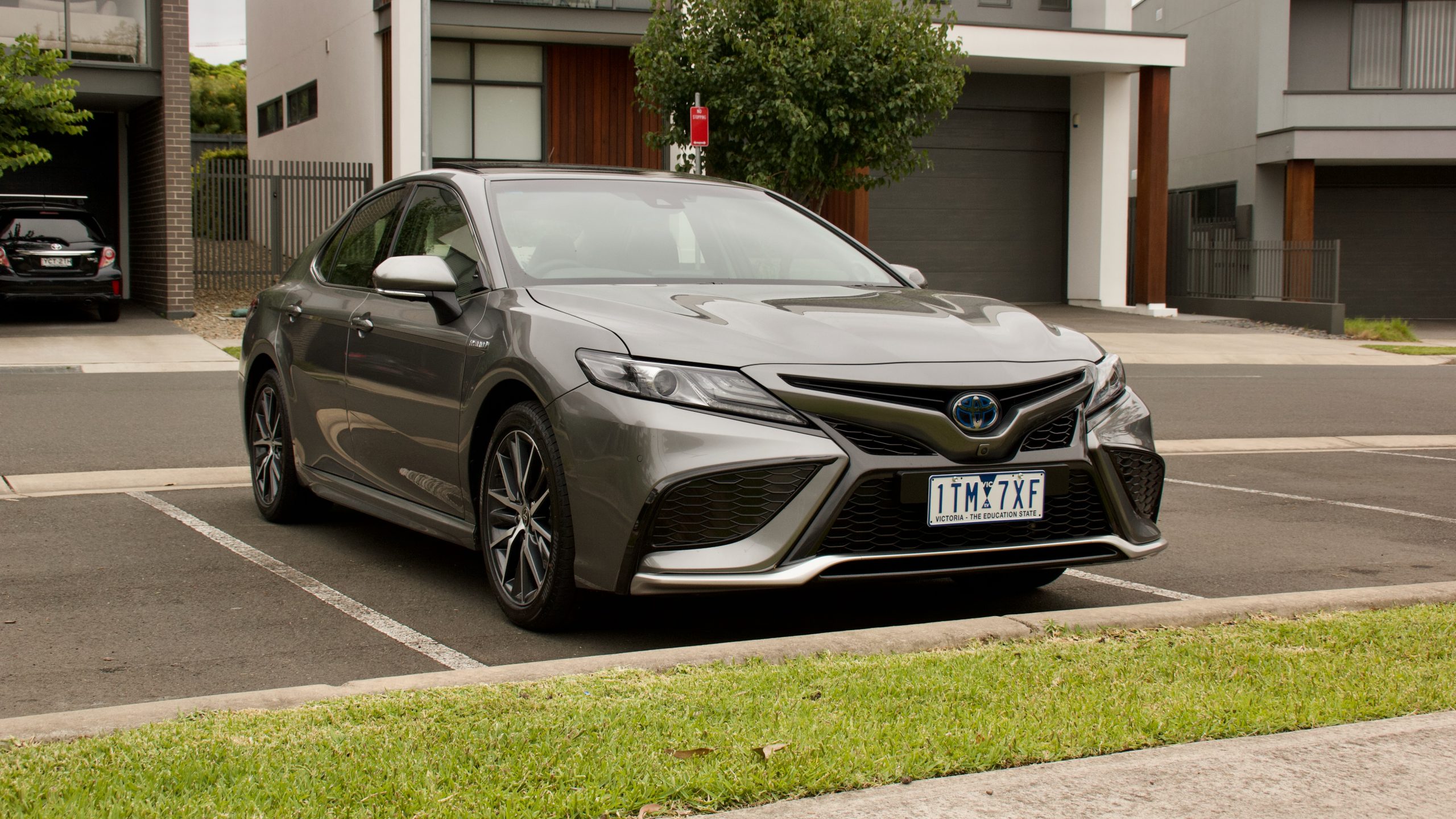
The current generation Camry debuted in Australia late 2017, surprising many by delivering, for the first time, a motoring experience that was more than just competent. Gone were the days of the Camry being seen as completely pedestrian. The new TNGA platform delivered a huge jump in handling and driving dynamics; the new hybrid drivetrain was a big jump; the list of standard safety features was long; and both the interior and exterior were modern and stylish. Despite the new lease of life, Toyota managed to retain what makes a Camry, a Camry—that being ease of use, reliability, and comfort.
Price & Equipment: 7/10
The 2022 Toyota Camry range opens at $30,990 plus on-road costs (around $35,000 drive away, depending on your location) for the base variant. As before the facelift, there are four variants: the base Ascent, mid-range Ascent Sport, ‘sporty’ SX and luxury SL. Our test car was the top-spec SL, in ‘Liquid Mercury’ paint priced at $47,565 plus on-road costs (around $53,000 drive away, depending on your location).
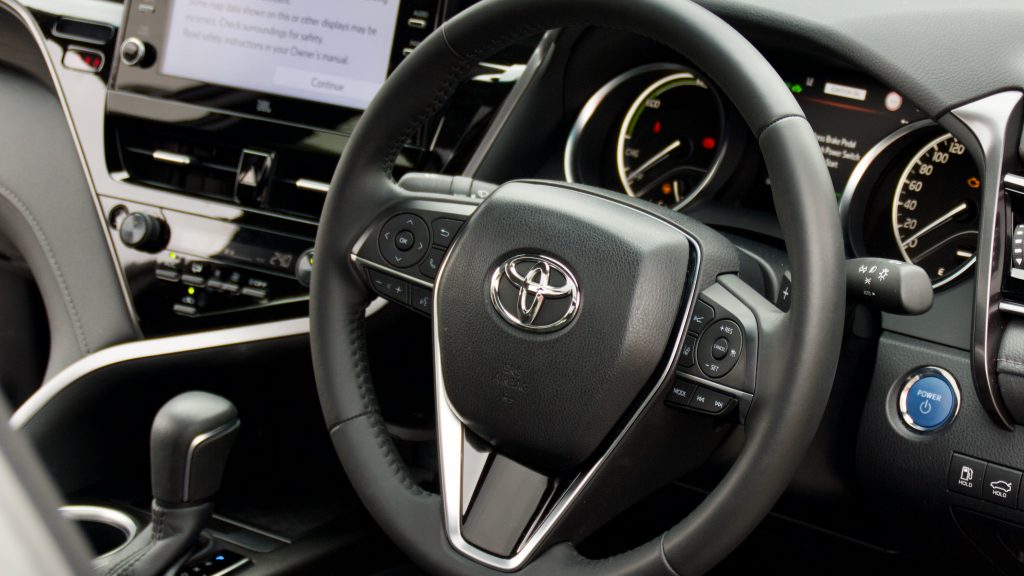
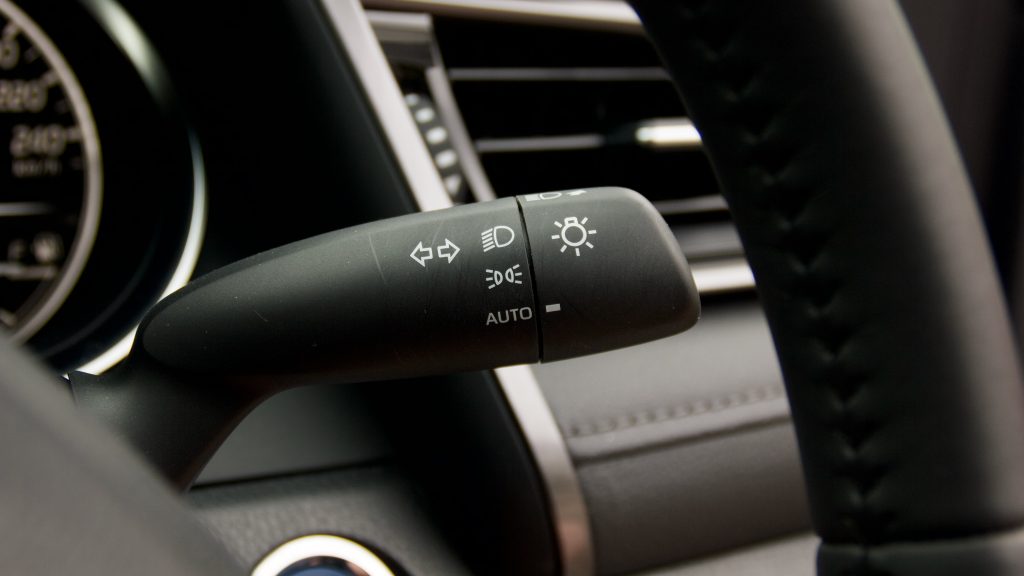
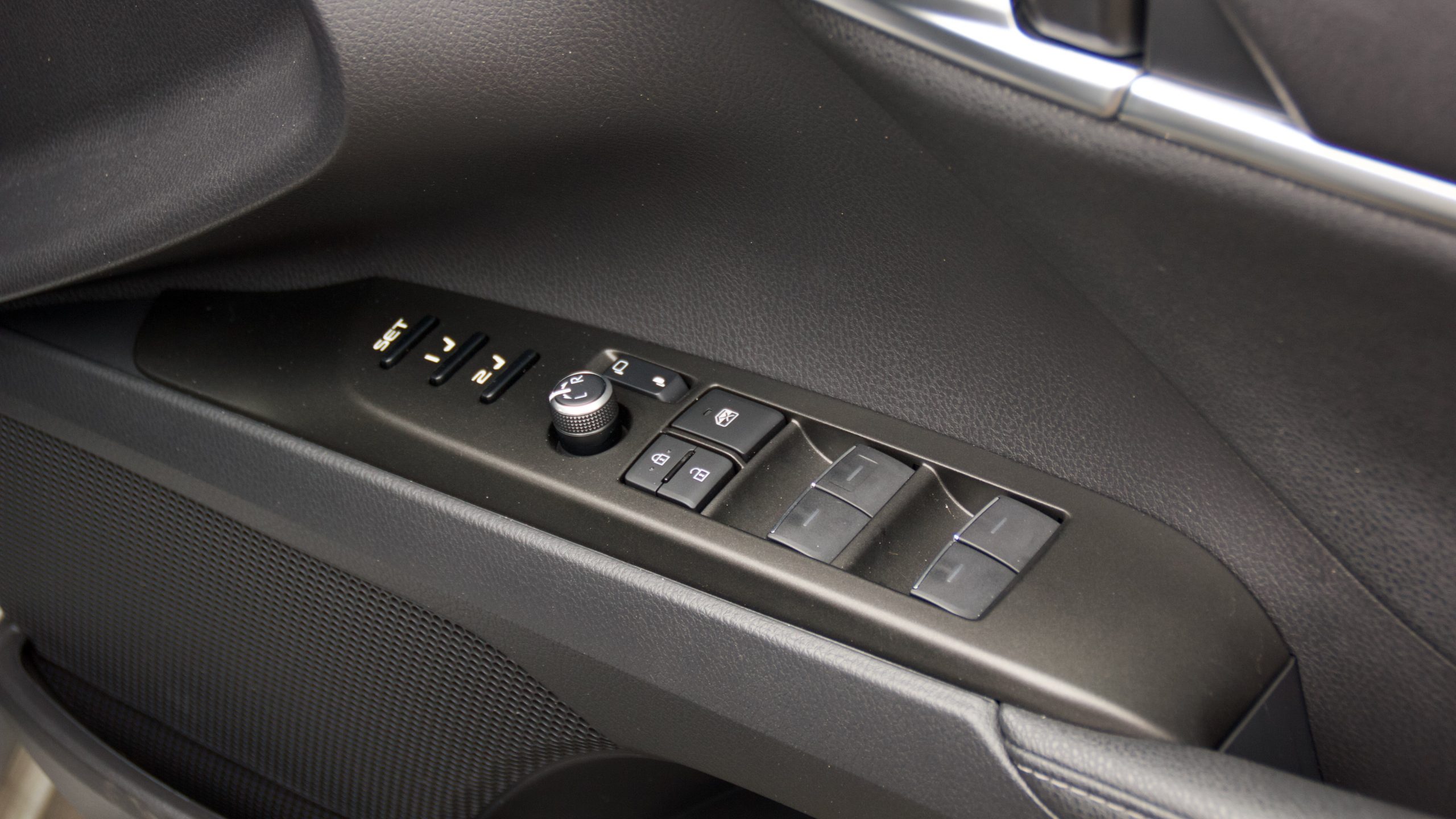
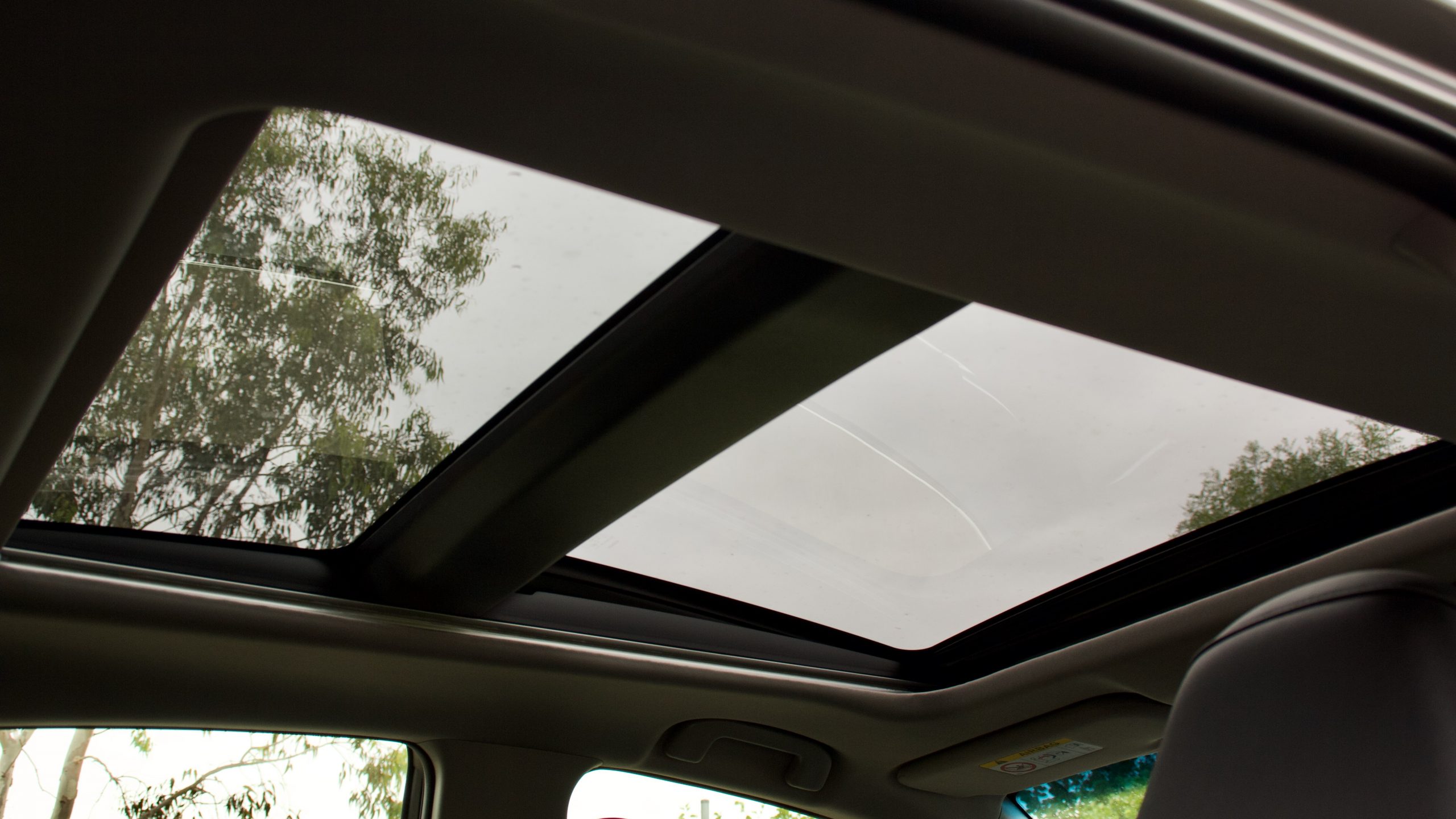
At the top of the 2022 Toyota Camry range, the SL receives plenty of equipment. This includes a new tablet-style 9.0-inch touchscreen with wired Apple CarPlay and Android Auto, satellite navigation with live traffic, digital radio, 8-way electrically adjustable front seats with driver’s memory, ventilated and heated front seats, dual-zone climate control with rear vents, automatic headlights and wipers, a panoramic sunroof, 18-inch alloy wheels, a 7.0-inch driver’s display, a nine-speaker JBL sound system, electric-folding mirrors, a 10-inch heads-up display and all-LED exterior lighting.
Safety is taken care of across the 2022 Camry range, which carries a 5-star ANCAP safety rating. All models have seven airbags and an upgraded version of Toyota’s autonomous safety suite, dubbed ‘Toyota Safety Sense’, featuring high and low-speed auto emergency braking (AEB) with pedestrian (day and night) and cyclist (day) detection, lane departure warning, lane keep assist, adaptive cruise control, auto high beam, intersection turn assistance, road sign recognition, lane trace assist and emergency steering assist. The SL also features blind-spot monitoring with rear cross-traffic alert.
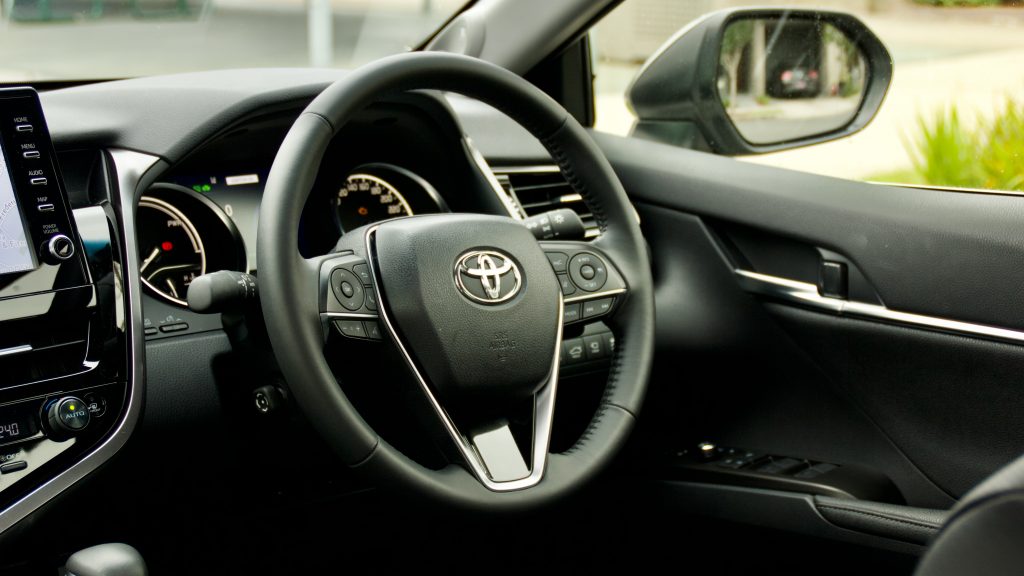
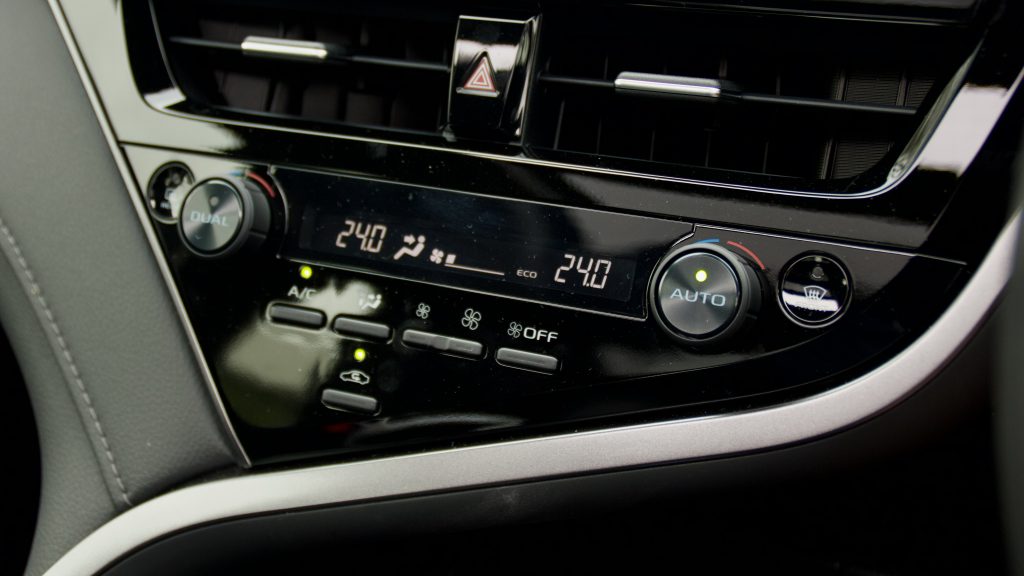
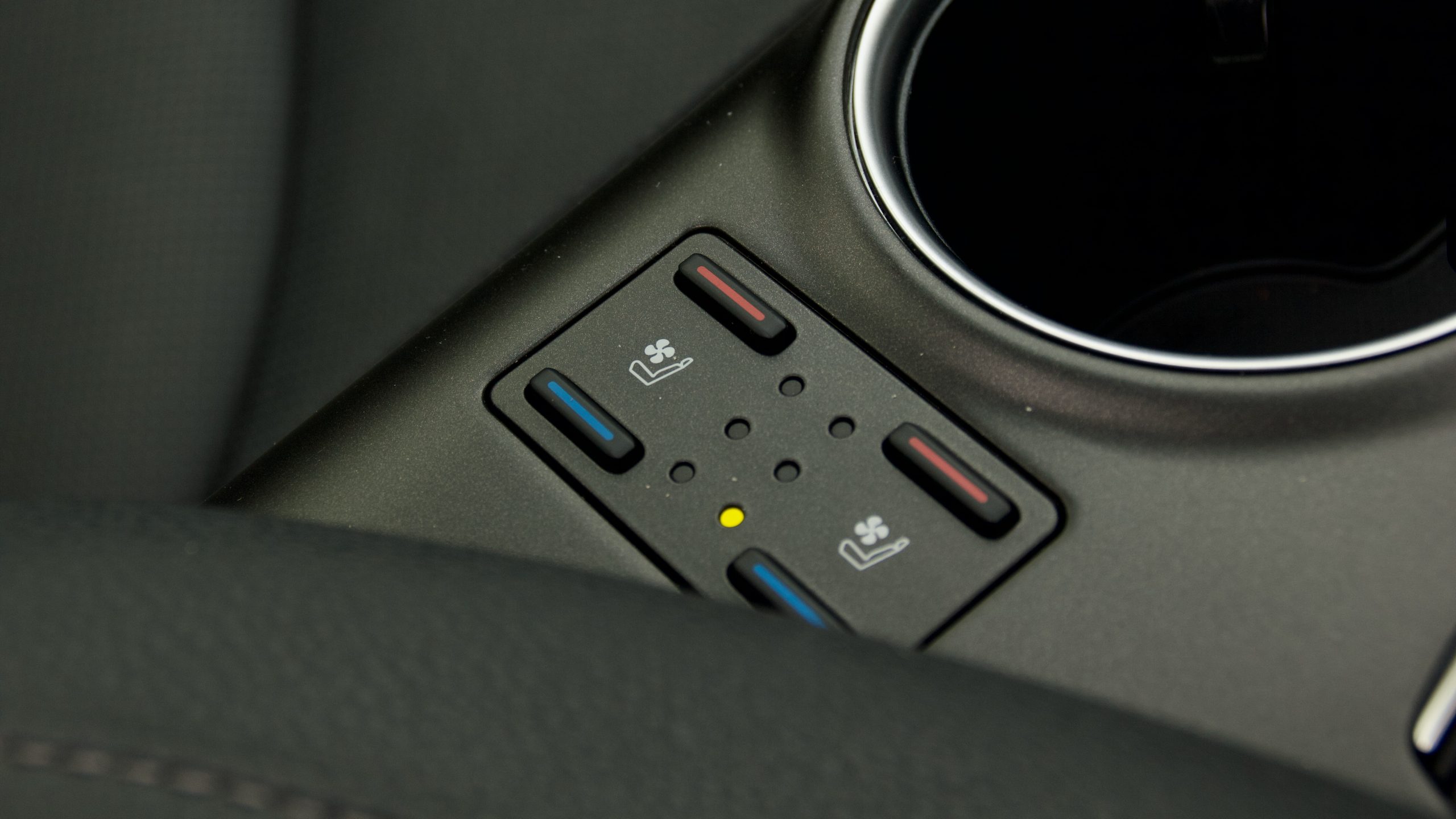
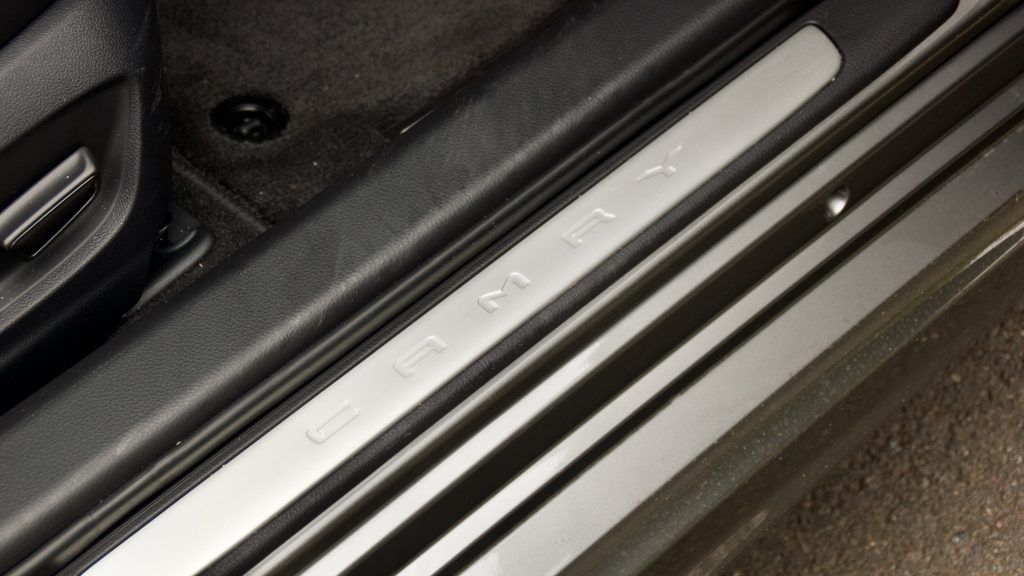
As part of the 2021 facelift, all Camrys now feature a communication module and a three-year subscription to ‘Toyota Connected Services’, a system which can call Toyota’s emergency call centre and send the location of the vehicle if an airbag is deployed or a collision is detected. There is also an SOS button to allow drivers to manually request assistance from the call centre and the ability for location tracking to track the vehicle if it is stolen.
While the equipment list is quite generous and the facelift added some appreciated features, we think there is still room for improvement. The electrically retractable mirrors should be automatic and heated on a car at this price level, and is a strange omission given these features are seen on top trim levels of many other Toyotas. Fog lights, a wireless phone charger, a secondary USB charger upfront and a fully digital driver’s display all feature on other cars that compete with the Camry, and we think these should be offered on the Camry SL. Toyota also continues to omit features that overseas models boast, such as air purifying technology and a number of rear seat amenities—including reclining and heated rear seats, a separate rear climate zone, a powered rear windscreen sunshade, door sunshades and a fold down instrument panel to control all these functions.
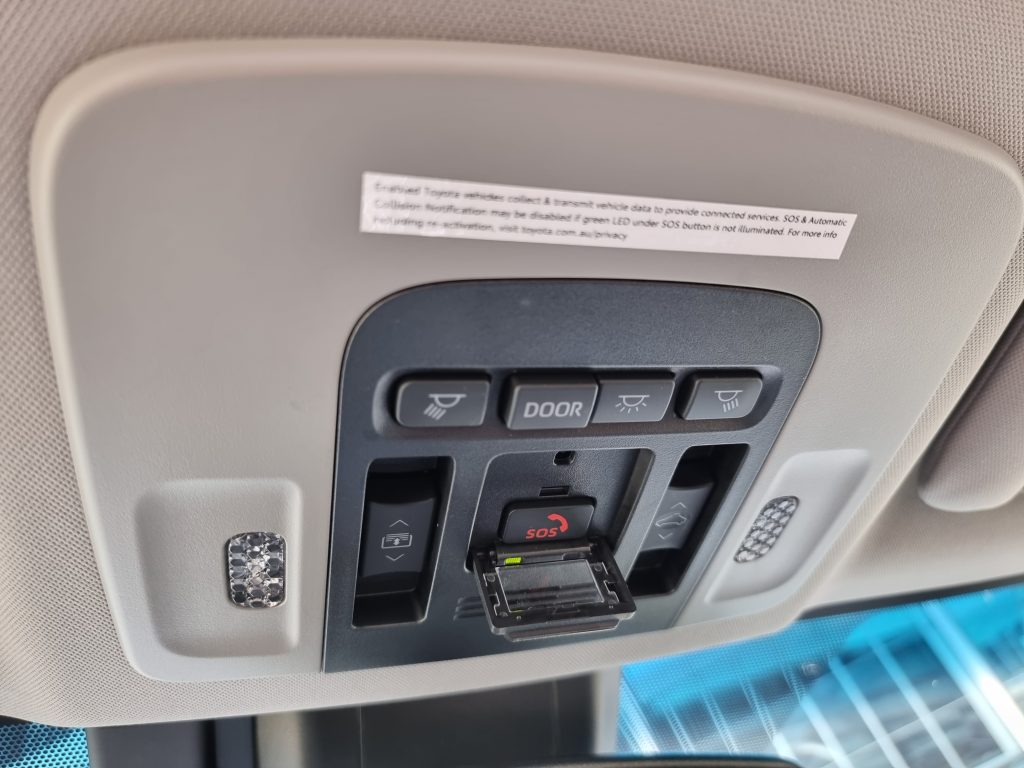
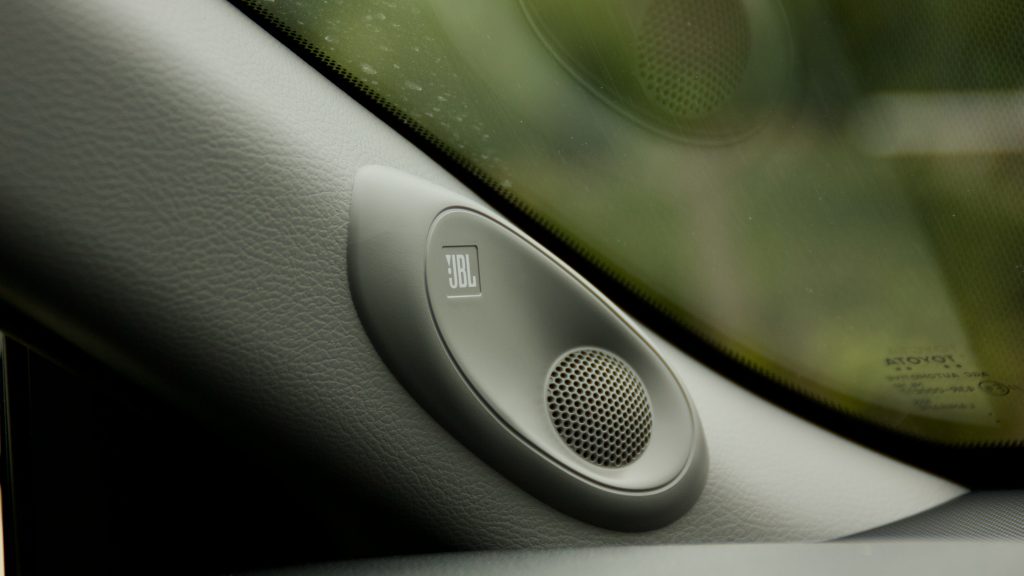
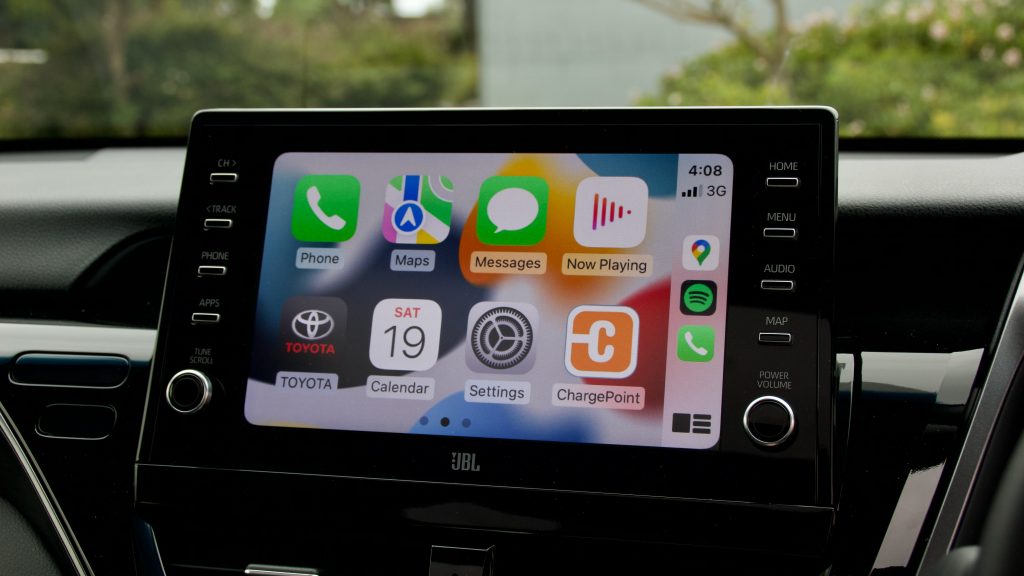
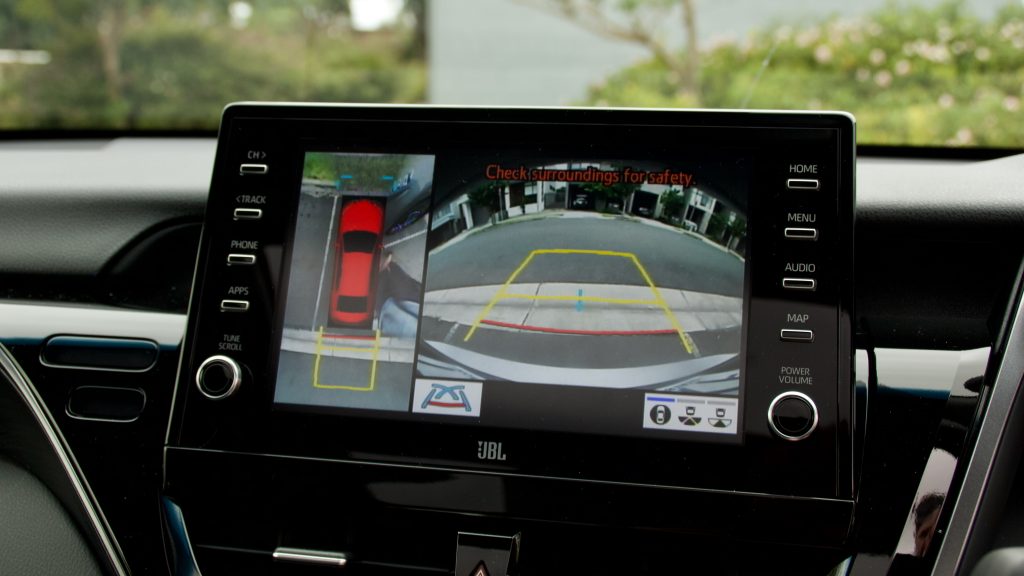
As previously mentioned, the Camry’s market segment has been on a steady decline for years, meaning fewer competitors than in the past and even fewer offering an equivalent size with a hybrid drivetrain. The only other similarly sized hybrid sedan is the Honda Accord VTi-LX hybrid at $60,400 driveway. Non-hybrid competitors include the $50,990 plus on-road costs (around $55,000 drive away) Mazda6 Atenza and the $51,490 drive away Skoda Octavia 140TSI Limited Edition.
Performance & Economy: 9/10
As with other Toyota models, the Camry’s 2.5-litre hybrid system pairs a naturally aspirated ‘Dynamic Force’ high compression Atkinson Cycle engine with an electric motor. The petrol engine outputs 131kW of power (at 5,700 rpm) with 221Nm of torque (at 3600rpm–5200rpm), and the electric motor produces 88kW and 202Nm of torque—this gives a combined output of 160kW. The electric motor is powered by a 259V lithium-ion battery, which was introduced to the Camry in August of 2020, replacing an older style nickel-metal hydride battery. The battery is charged through a combination of regenerative braking and the electric motor moonlighting as a generator to produce electricity while coasting or decelerating, and on occasion, while idling with the petrol engine running.
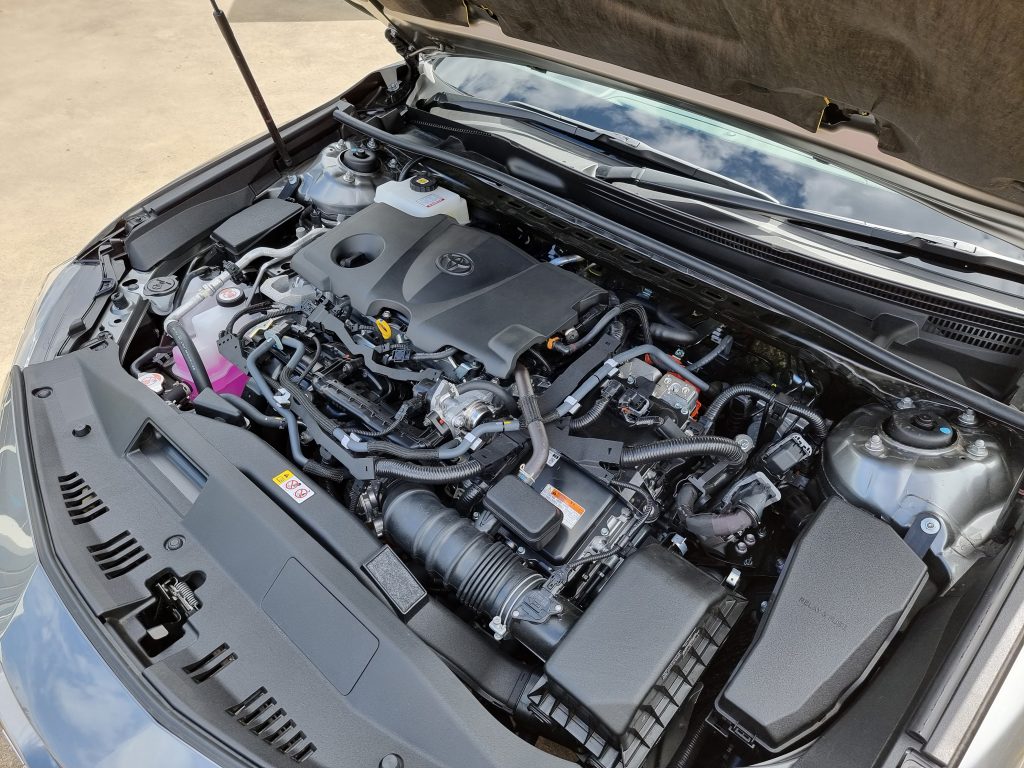
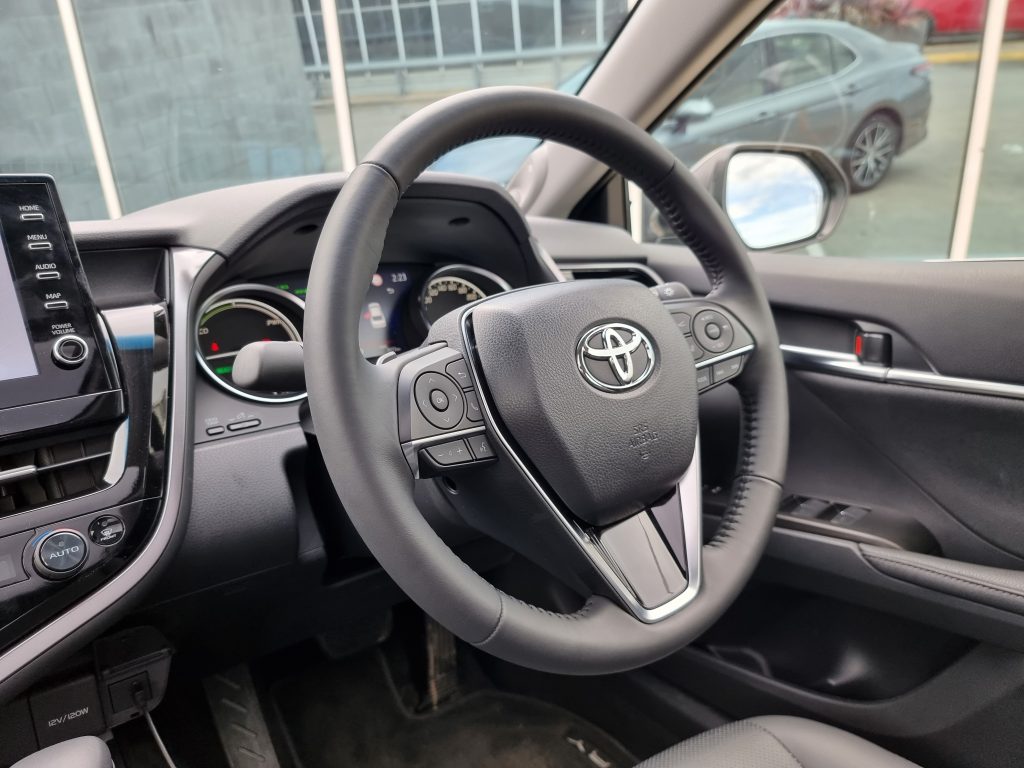
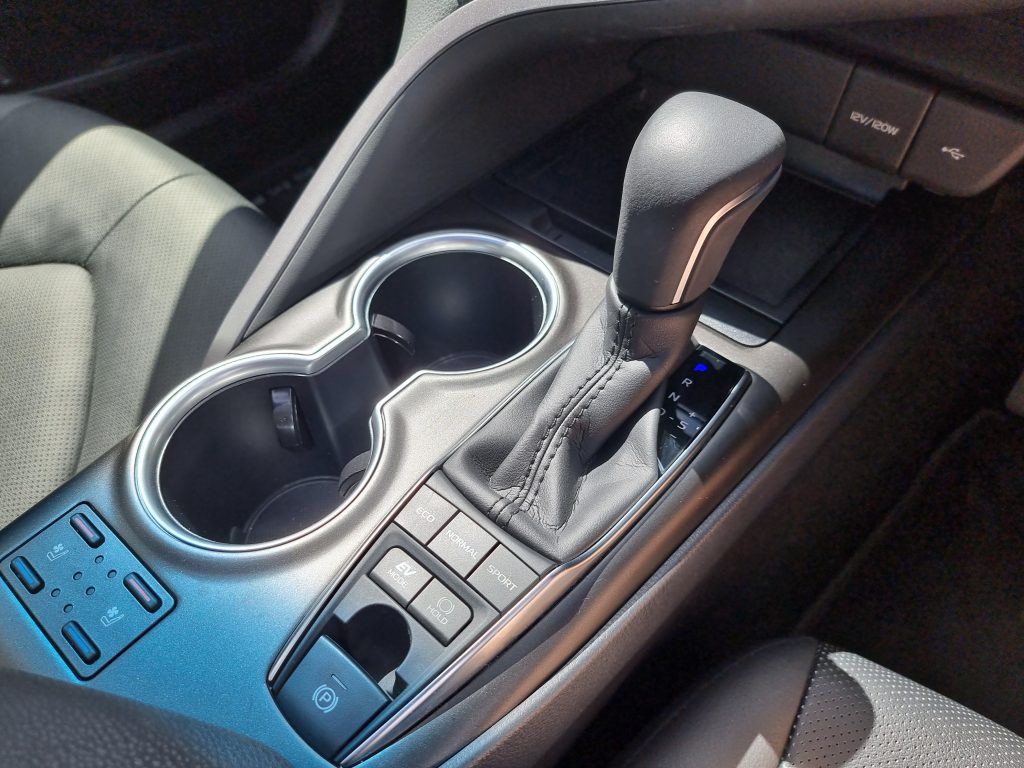
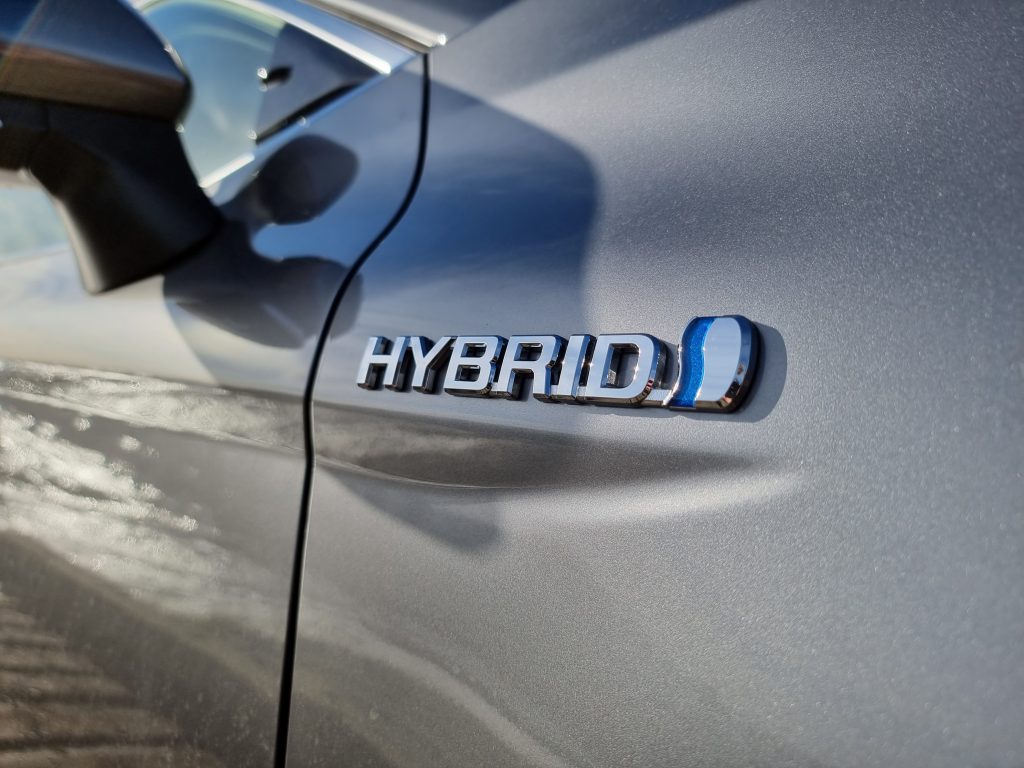
The goal of the clever hybrid system is simple: to use as little petrol as possible. To achieve this, acceleration is provided by a mixture of electric only, petrol and electric and petrol only based on what will achieve the best efficiency but also appropriate power for any given driving situation. Light acceleration is often provided purely by the electric motor, with the petrol engine cutting in when more spirited acceleration is required. Often once a coasting speed has been reached, the petrol engine will switch off completely, leaving the electric motor to maintain speed. Unless the battery is low, the petrol engine remains off at idle.
The beauty of the implementation of Toyota’s hybrid system is while this all sounds complex, it’s barely noticeable to the driver. The starting and stopping of the petrol engine is buttery smooth and the switch between differing methods of propulsion are subdued. This means that the hybrid Camry can be driven like a traditional petrol-powered car, with very little attention paid to the myriad of technologies working in the background, while still returning great fuel efficiency.
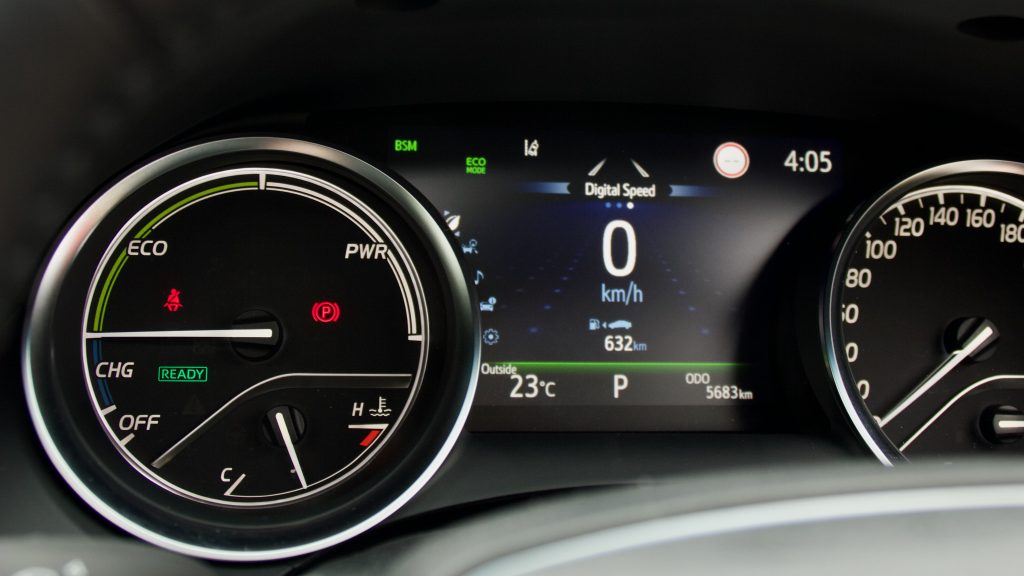
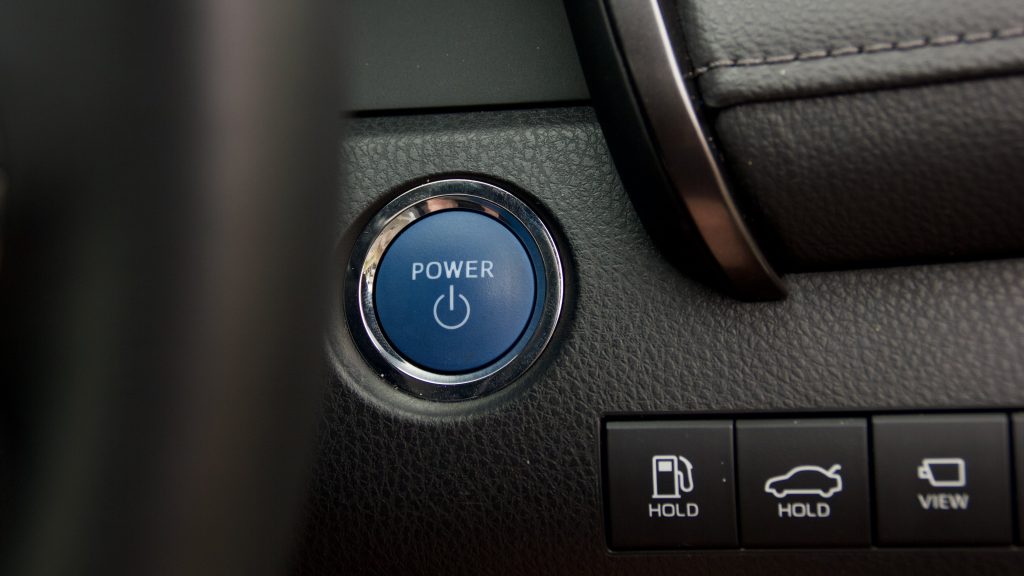
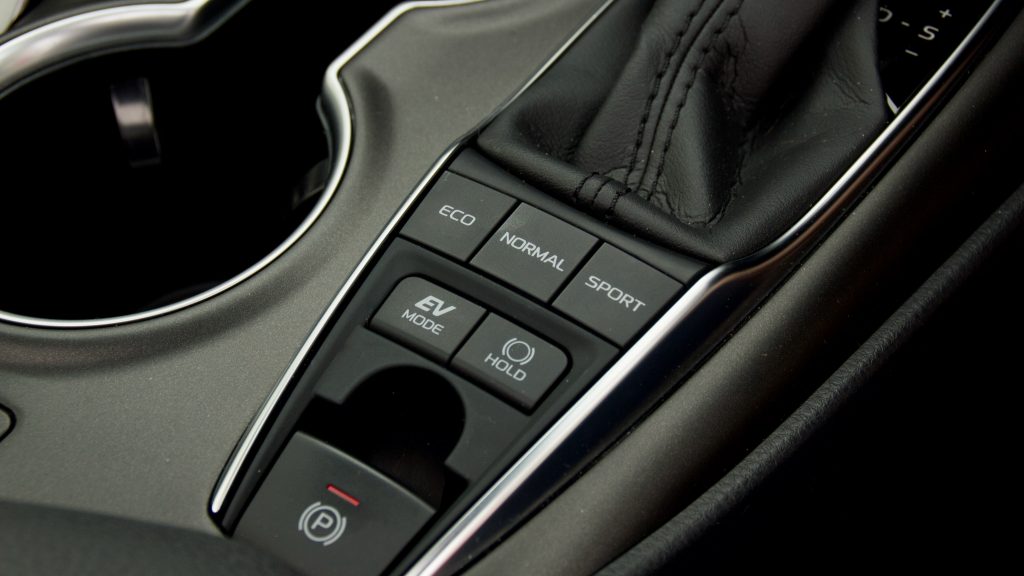
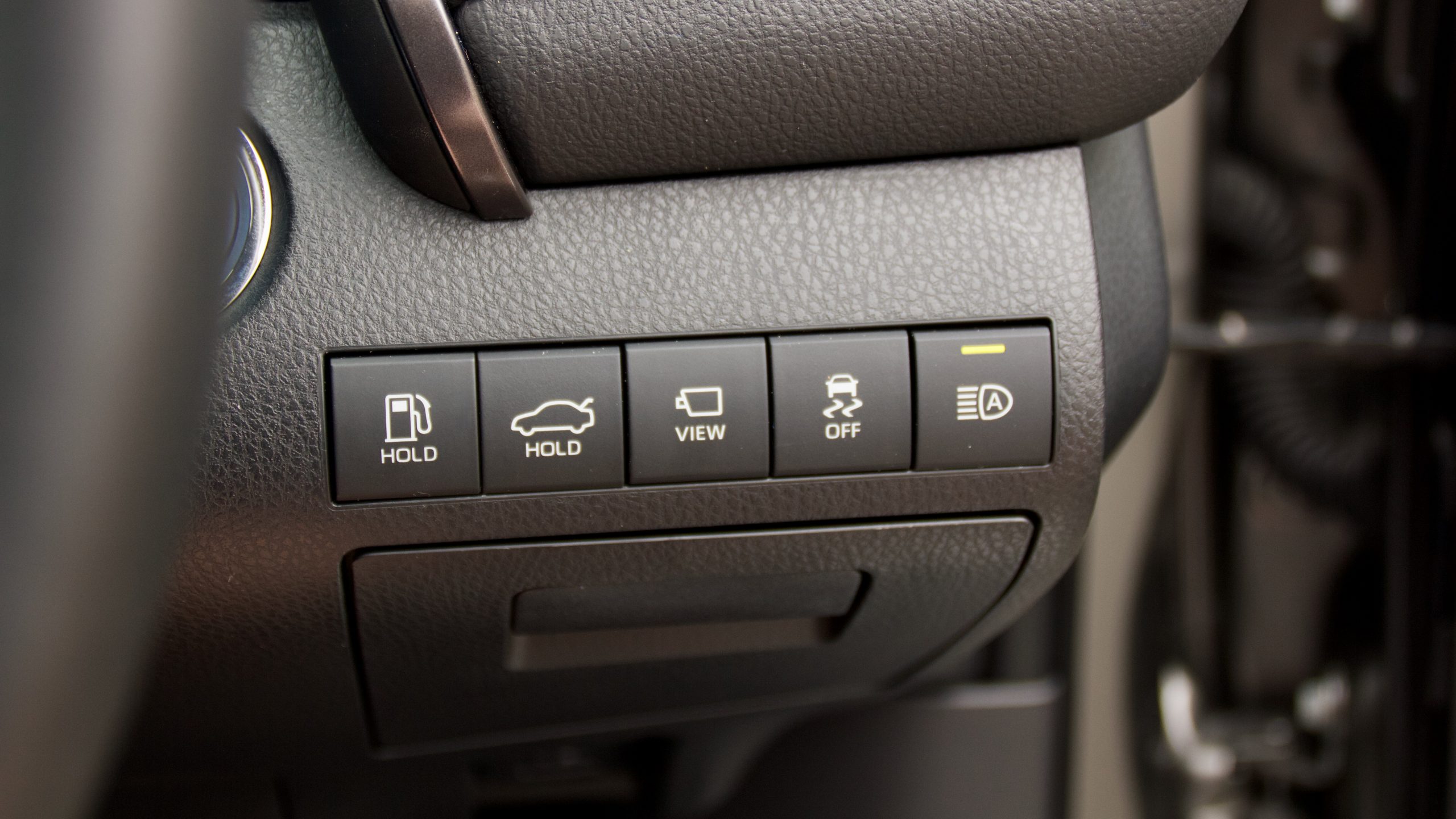
Three driving modes are provided. ‘Eco’, ‘Normal’ and ‘Sport’, and they change how the hybrid system works to deliver a different acceleration experience. ‘Eco’ dulls acceleration, ‘Sport’ sharpens up the accelerator response and invokes the petrol engine more often, while here is also an ‘EV mode’, which, provided there is enough battery charge, allows you to drive on battery power alone with greater acceleration under 40km/h.
Driving a Camry hybrid can quickly turn into a bit of a game of being as efficient as possible. Pop the ‘Eco’ drive mode on and use the hybrid system monitor, and you soon learn exactly how to stay on electric-only power for as long as possible and how to brake to get the most charge from the regenerative braking system. The Camry will even give you a score out of a hundred on how ‘eco’ your drive was, judging based on acceleration, coasting, and braking, plus suggestions to improve.
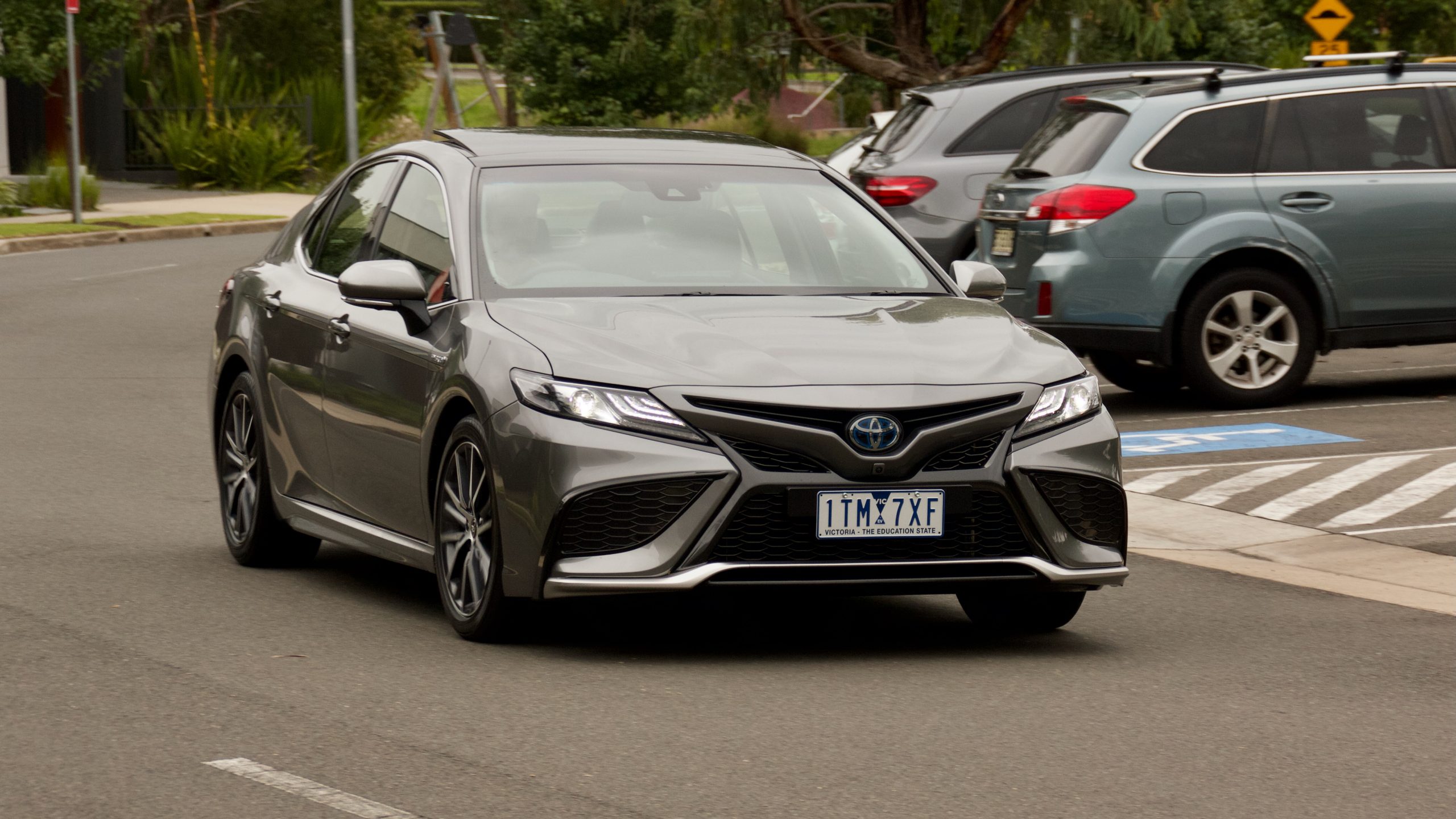
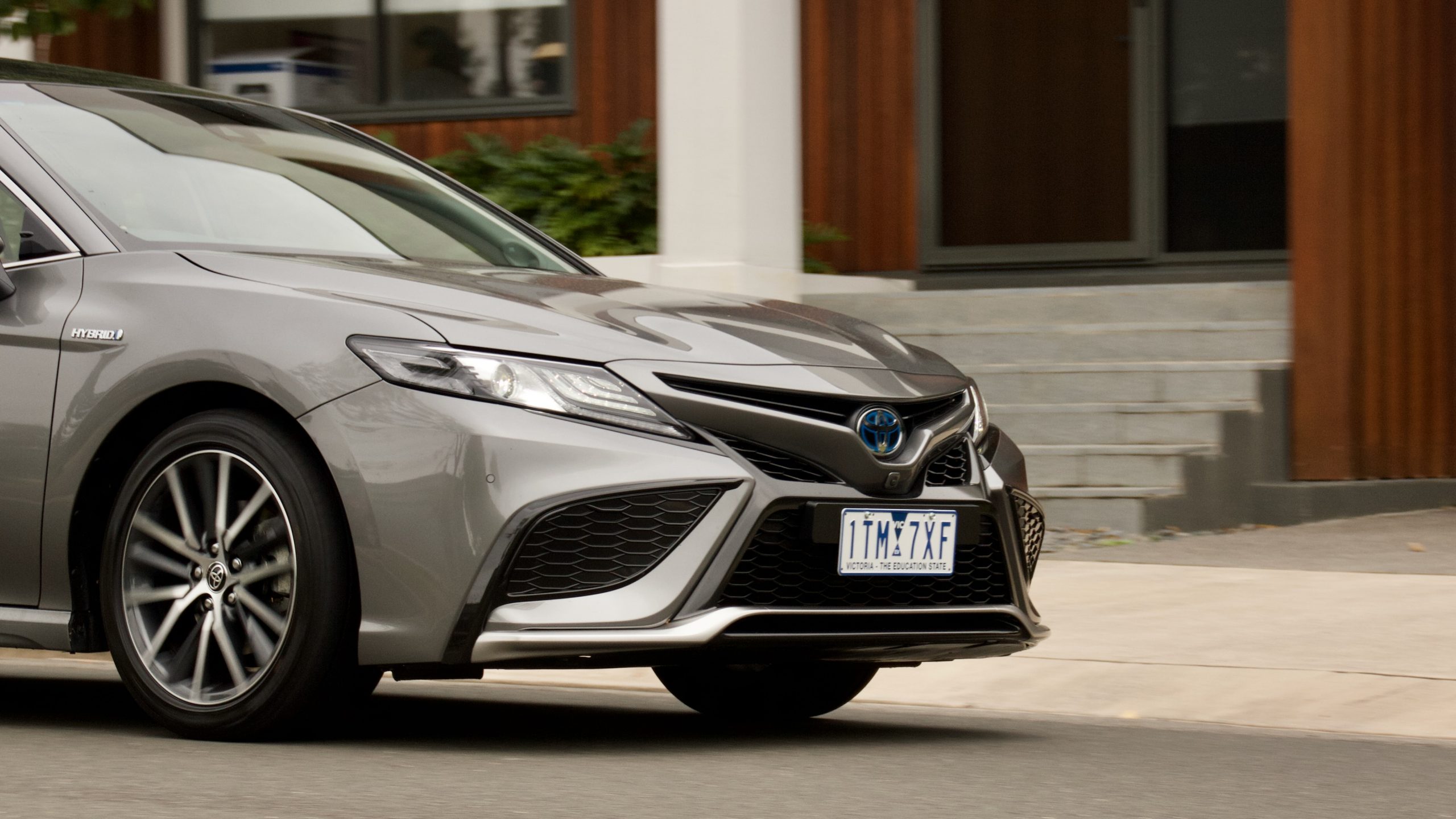
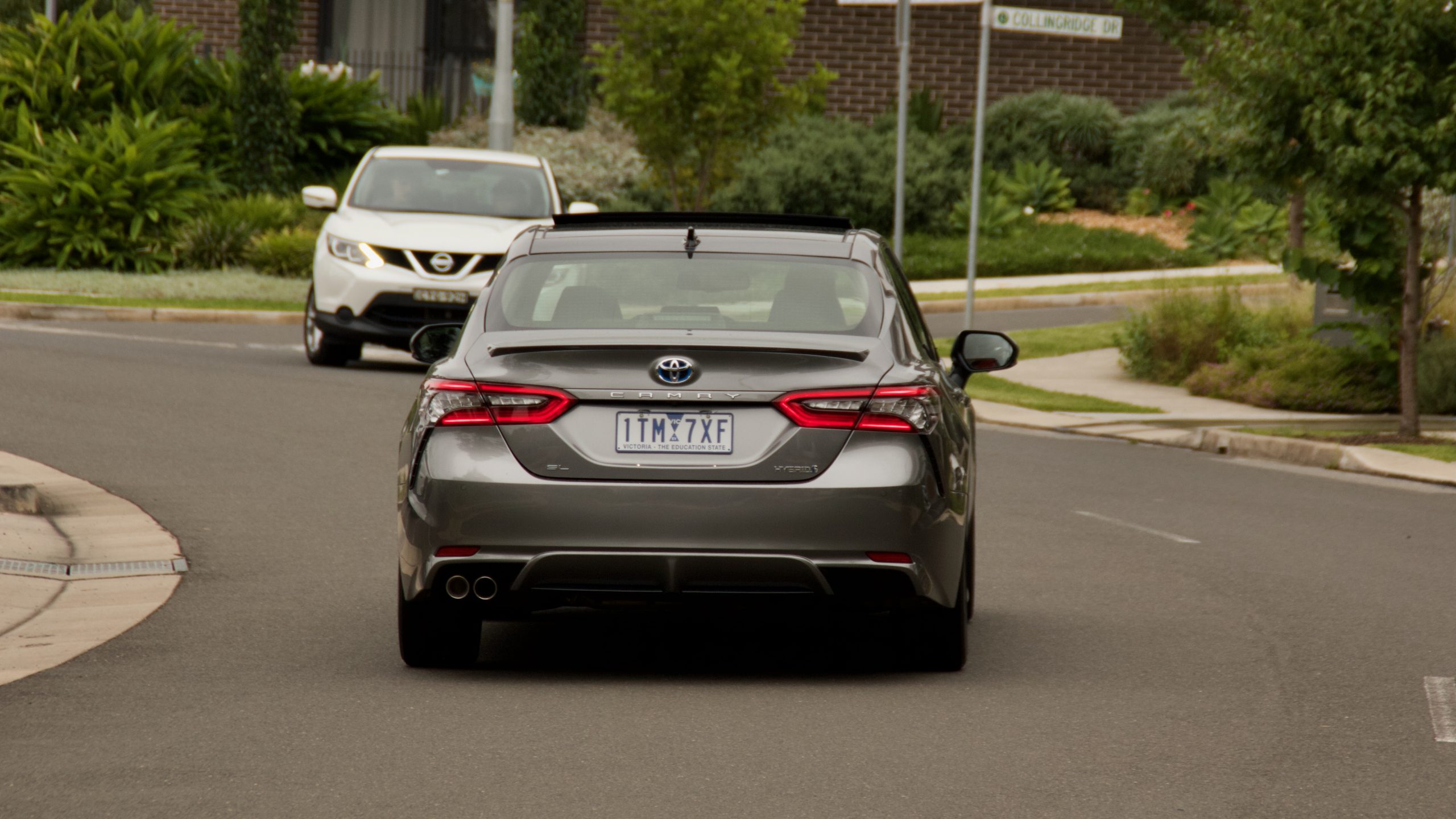
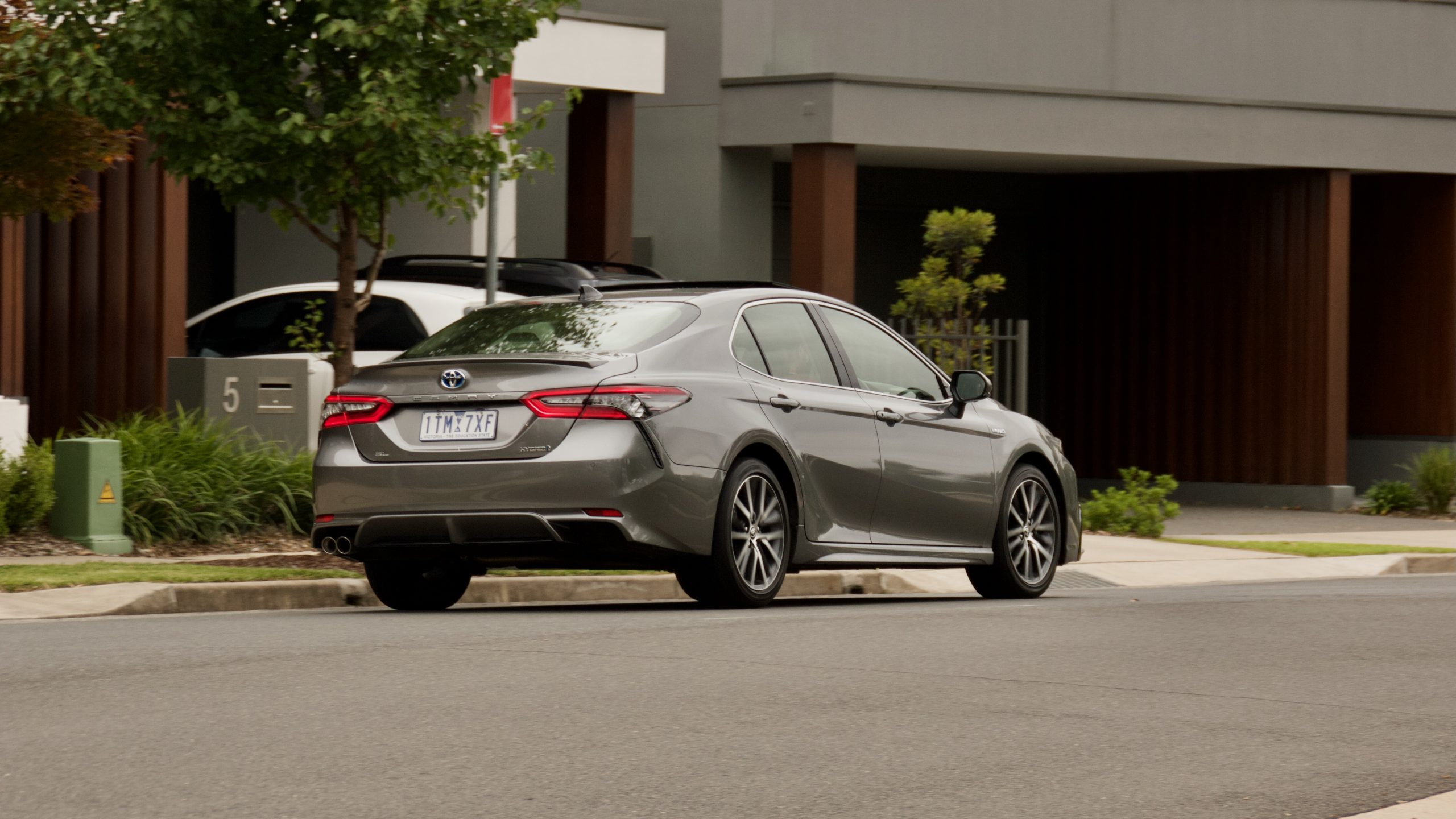
Despite its eco-friendly credentials, the Camry hybrid is no slouch—while not class leading, it does a 0–100kmh sprint in around 8.3 seconds which is more than acceptable. When a quick burst of acceleration is needed, for overtaking or getting up to speed, the hybrid system is responsive and more than capable of delivering the required power. Toyota’s e-CVT transmission is somewhere between a standard CVT and a traditional automatic. In normal driving, the e-CVT lacks defined shift points of most automatics, but it doesn’t tend to drone on acceleration like many detractors of CVTs report. For drivers who want a bit more control, the e-CVT can even imitate having six shift points, which can be shifted through manually using paddle shifters.
Over our week with the Camry SL hybrid, we returned an average fuel usage of 5.4L/100km from a mix of urban and highway driving. While it’s not the claimed 4.7L/100km, it’s close and is nonetheless excellent for a car of the Camry’s size. With this fuel usage, the Camry can travel over 900km between refuels.
Ride & Handling: 8/10
True to Camrys of the past, the 2022 Toyota Camry SL hybrid remains extremely easy to drive. The ride is quiet and refined, with excellent isolation of road, engine and wind noise—which is further helped by the amount of time that the petrol engine stays switched off. The suspension setup, which includes fully independent rear suspension, soaks up bumps and other road imperfections with aplomb. The steering is light with reasonable feel and only on occasion, while manoeuvring, is the sheer size and weight of the Camry is noticeable. Overall, this adds up to an extremely comfortable drive.
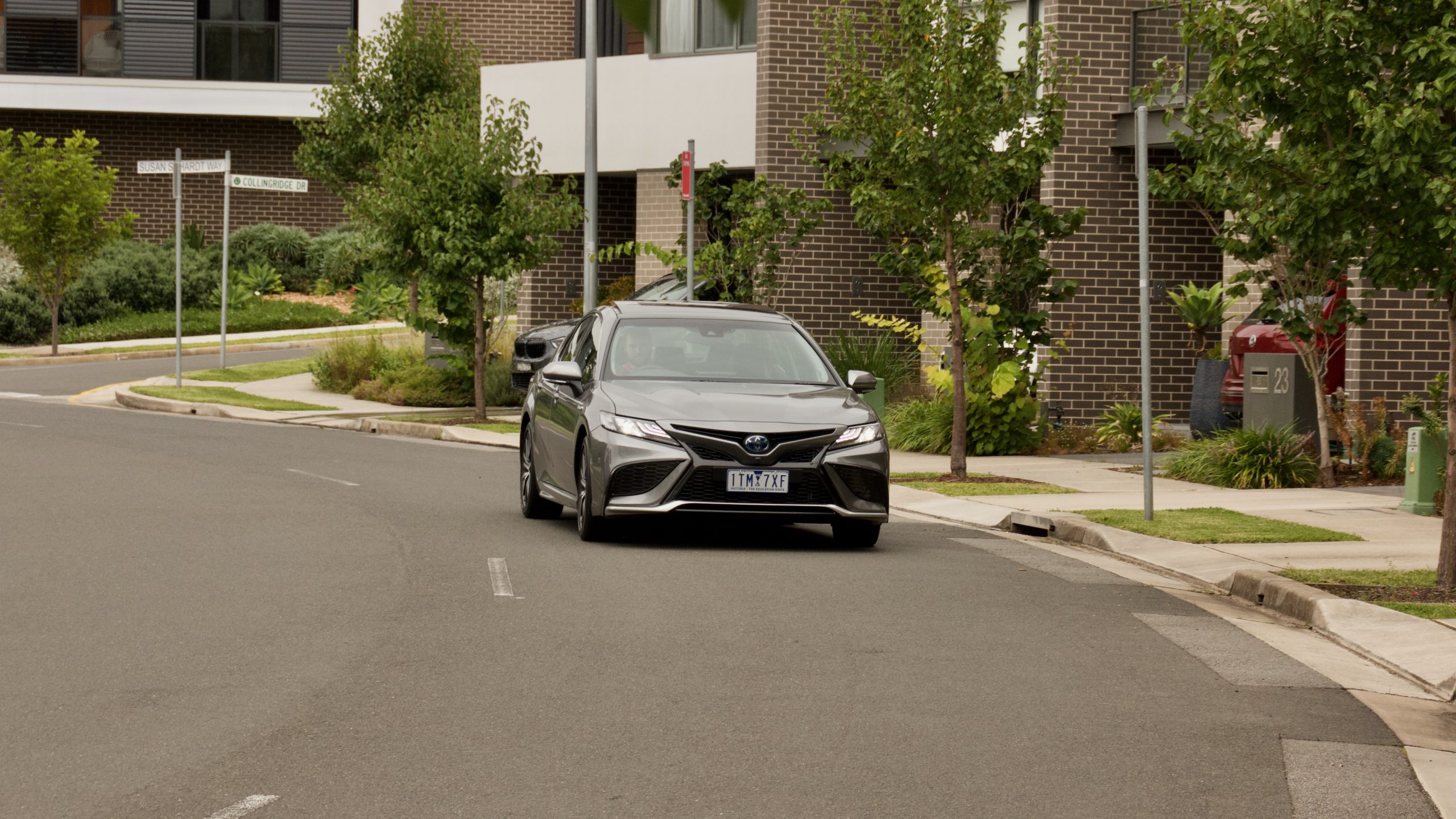
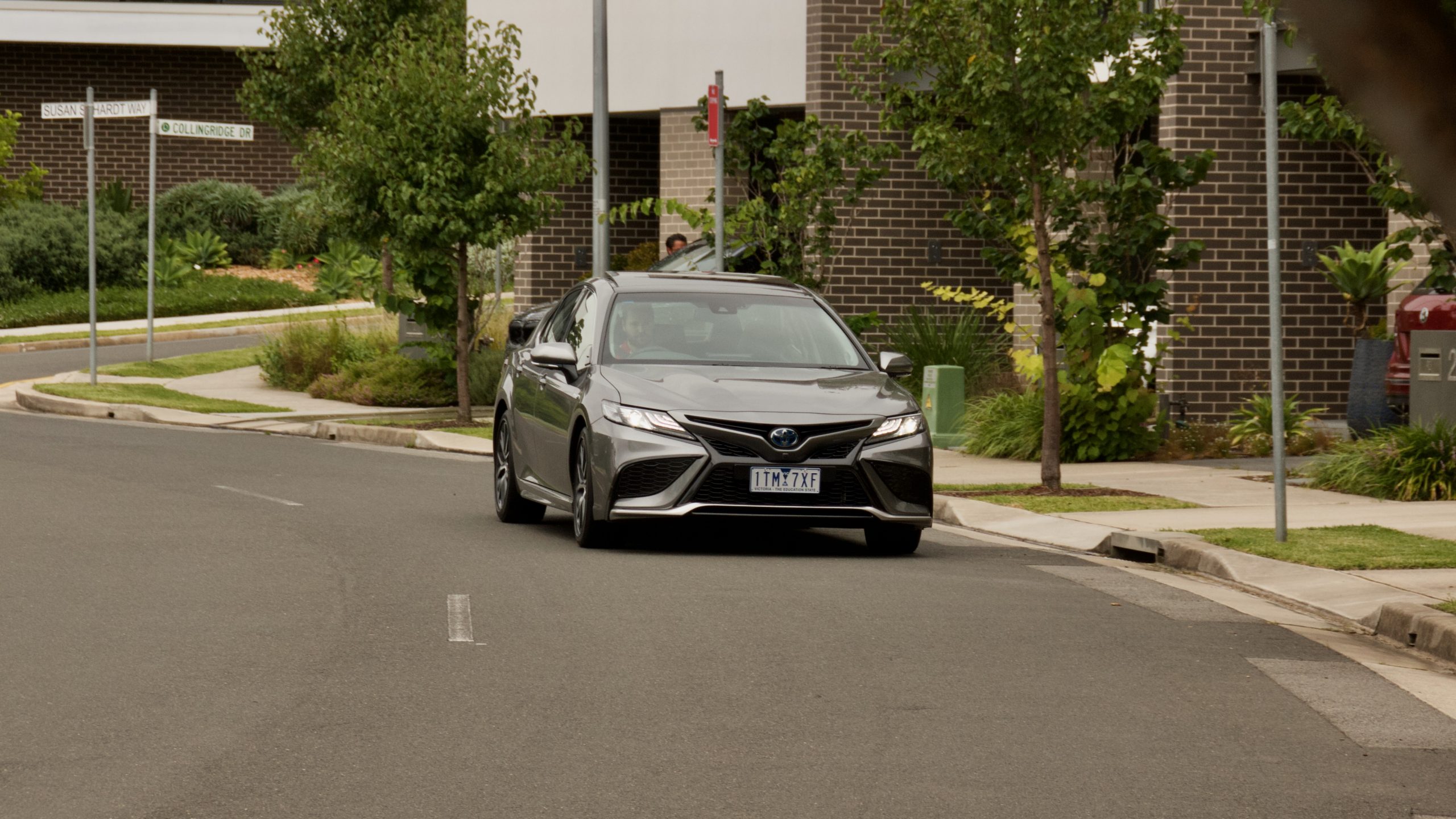
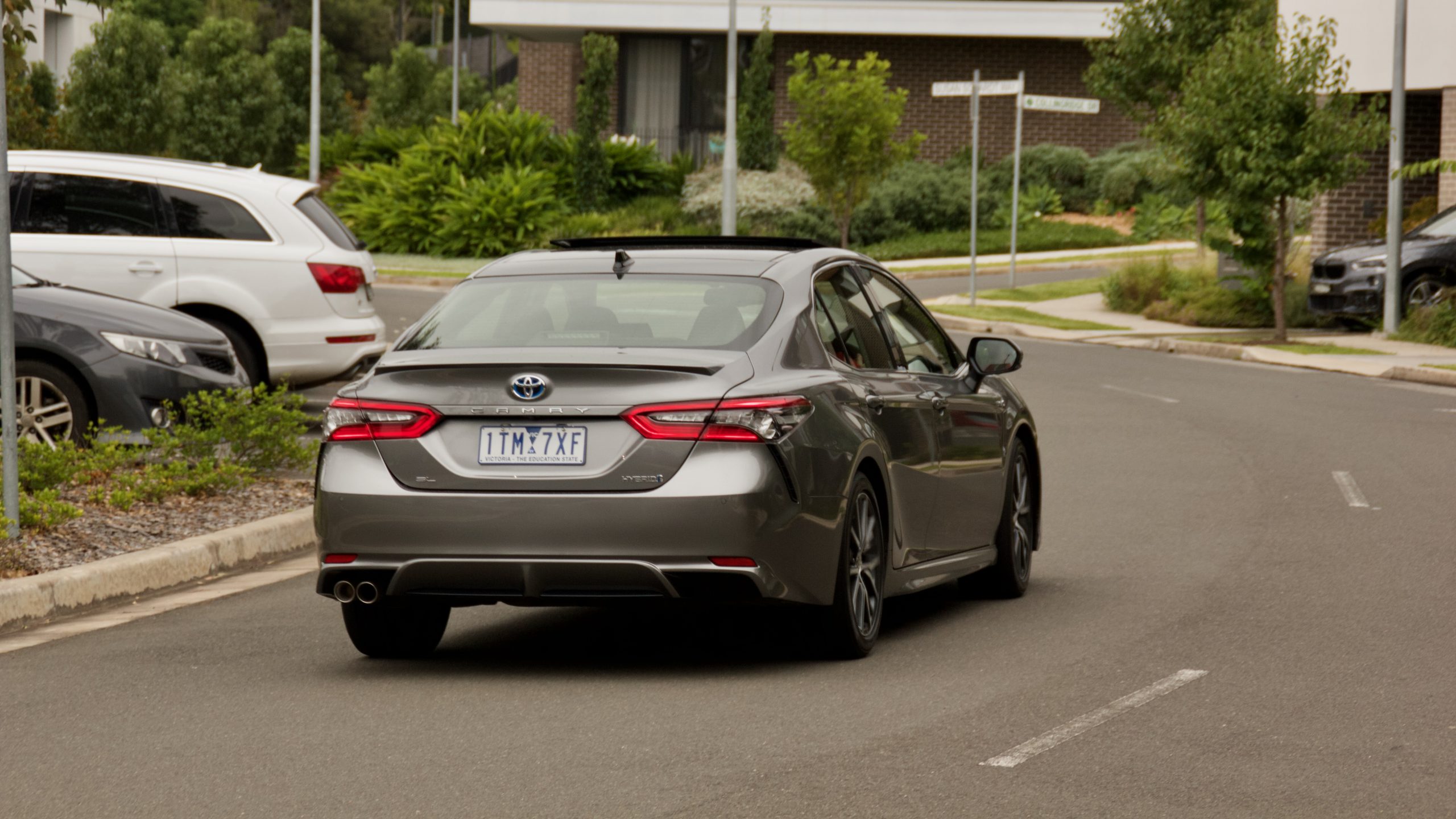
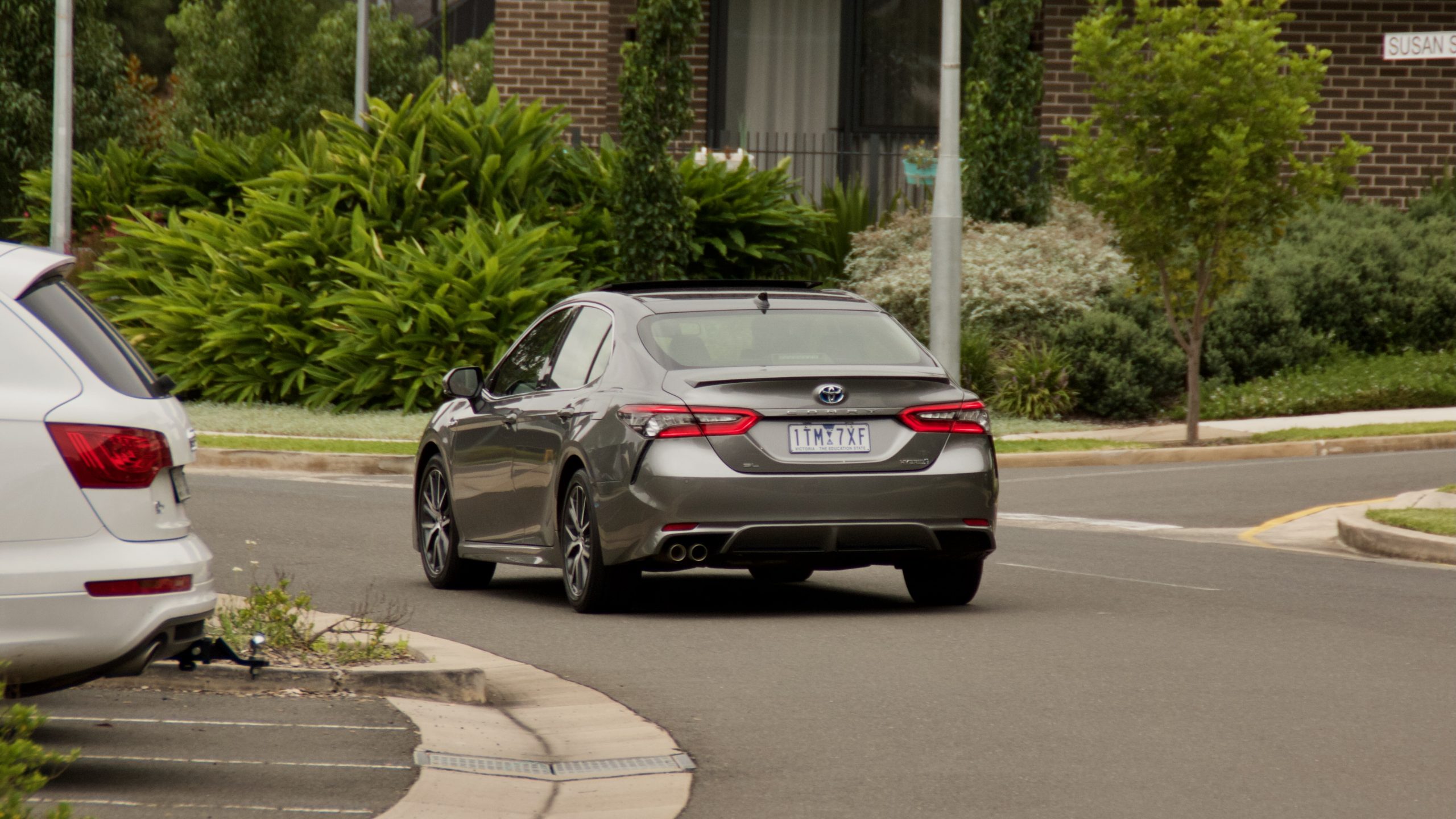
While the 2022 Toyota Camry SL Hybrid doesn’t handle as sharply as the Mazda6 or the Skoda Octavia, Toyota’s TNGA platform has succeeded in delivering a chassis which is more than capable of providing reasonable driving fun. The low driving position and width firmly plant the Camry on the ground and it grips well, holding its own while cornering. Body roll only rears its head when the Camry is pushed harder, which we don’t think most Camry drivers will partake in too often, if at all.
Interior & Practicality: 8/10
Though it’s been around since 2017, the Camry’s interior has held up well in material quality, available technology and in layout as well. The 2021 facelift was effective in making it more modern by increasing the size of the touchscreen and moving it above the centre air vents to give it the ‘floating tablet’ look. Throughout the interior, many of the surfaces are soft to the touch and interesting design elements such as the swoopy dash combine with and good-quality materials. This is further driven home by how solid and well put together everything feels—as you’d expect from a Toyota. The new (to the hybrid) panoramic sunroof helps keep an airy atmosphere. While it doesn’t quite feel as premium as some competitors, it comes close and is overall a lovely place to be.
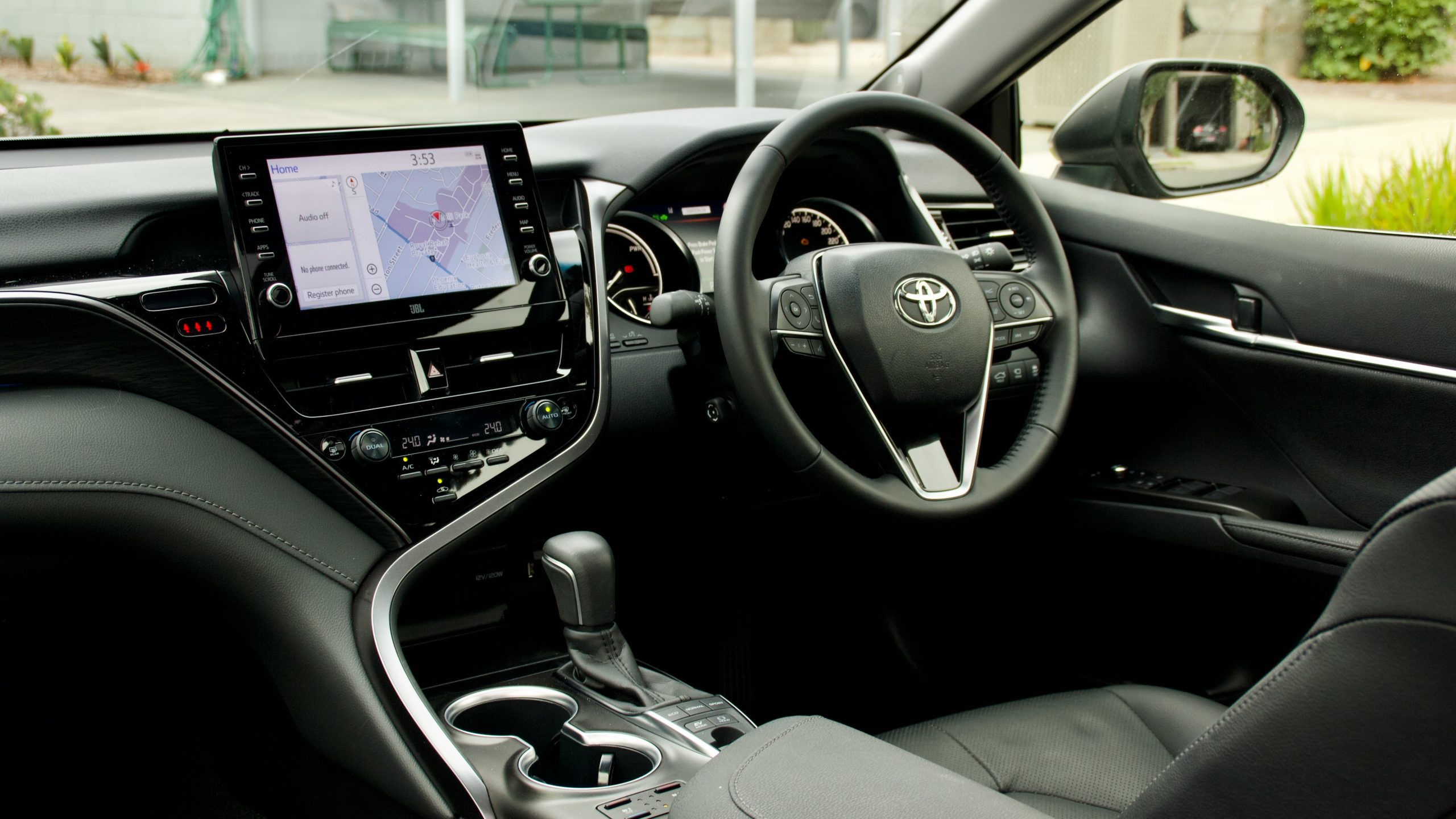
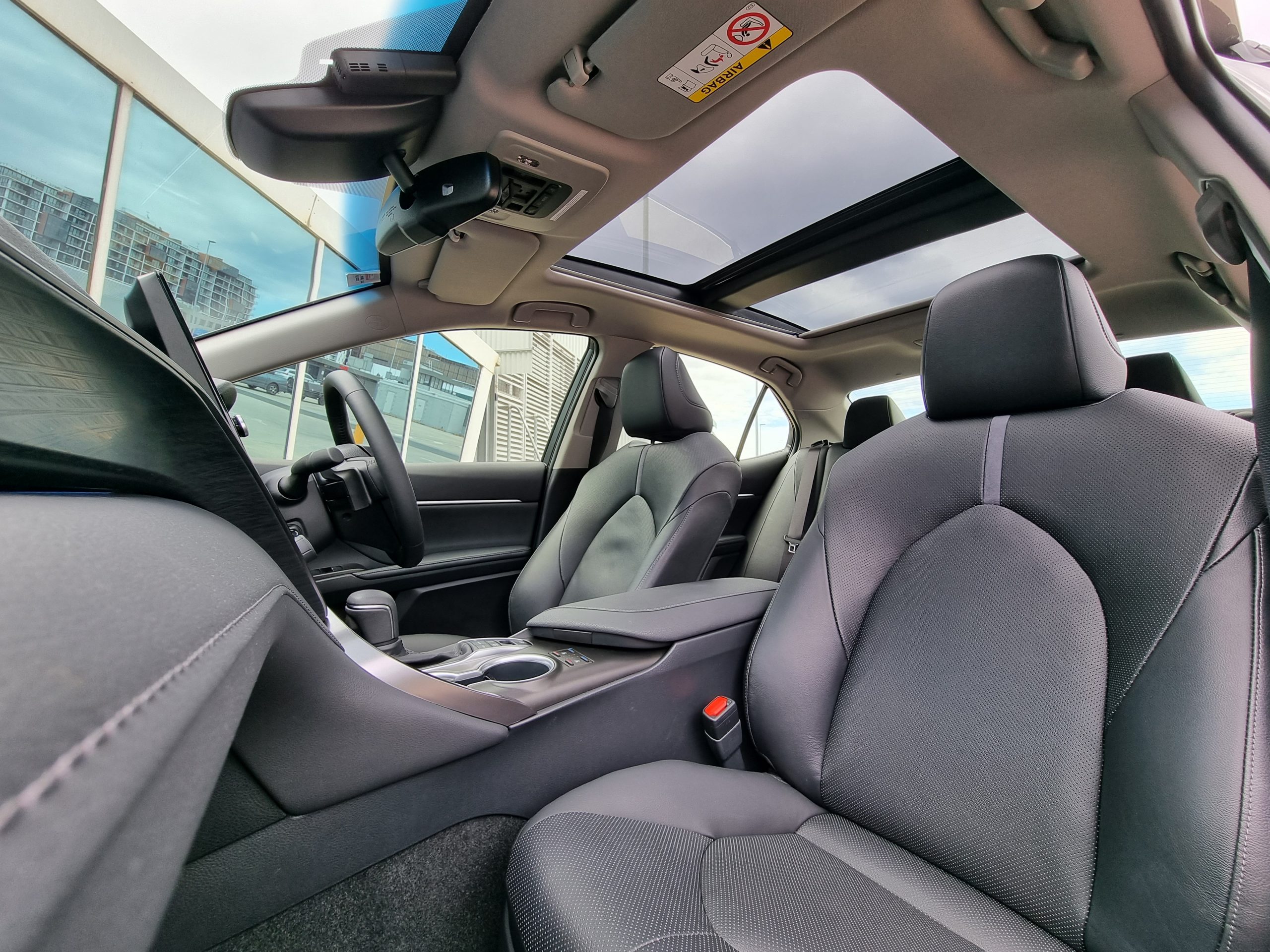

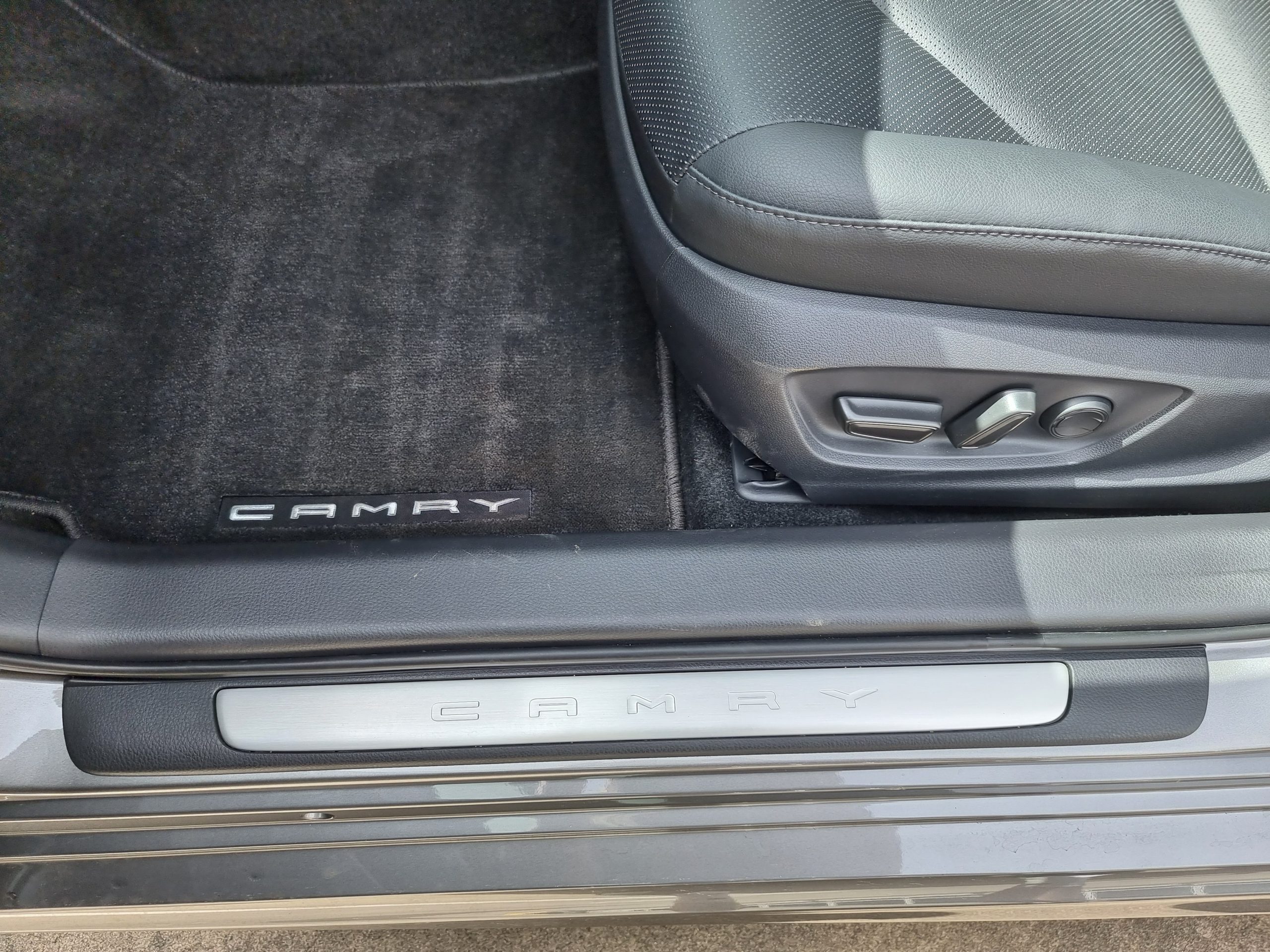
A bigger focus on design and quality hasn’t detracted from the utility of the cabin, though. There are plenty of well thought out storage spaces, including an immense centre console, large cupholders and door pockets and a useful cubby with a sliding cover in front of the drink holders – though it no longer features the wireless phone charger it used to have.
The front seats are trimmed in leather, which are nice to the touch. The seats themselves are comfortable enough, but we definitely found ourselves wishing that Toyota had used a more supportive design, similar to those found in the Corolla. However, with eight-way electric adjustment on both front seats, finding a comfortable driving position was easy, and with driver’s seat memory, maintaining a position between multiple drivers is even easier. The front seat ventilation was appreciated at this time of the year, and we were pleased to see that the 2021 facelift added seat heating as well.




The 9.0-inch touchscreen features the same software on most other Toyotas and offers phone mirroring through wired Apple CarPlay and Android Auto, satellite navigation and digital radio. While the system is easy enough to use, the screen resolution isn’t great. A crisper screen with smoother animations would certainly help the cabin feel more modern. Further, we found the cameras used for the reversing camera and panoramic view monitor to be quite fuzzy which cheapened our experience, which has been a common complaint of ours across the Toyota range. The new eleven speaker JBL system isn’t class leading but we thought it did an adequate job.
The second row of the 2022 Toyota Camry SL Hybrid is huge and the rear seats are supportive, with great leg room for the two outbound seats. Two adults or three children can easily fit across the back row—a shorter third adult can also fit in the middle seat with relative comfort. The main problem, space wise, for back seat occupants is the panoramic roof, which really eats into rear headroom. We were happy to see the soft touch materials continue onto the rear door panels and rear seat amenities include air vents and two USB-A ports for keeping devices charged.
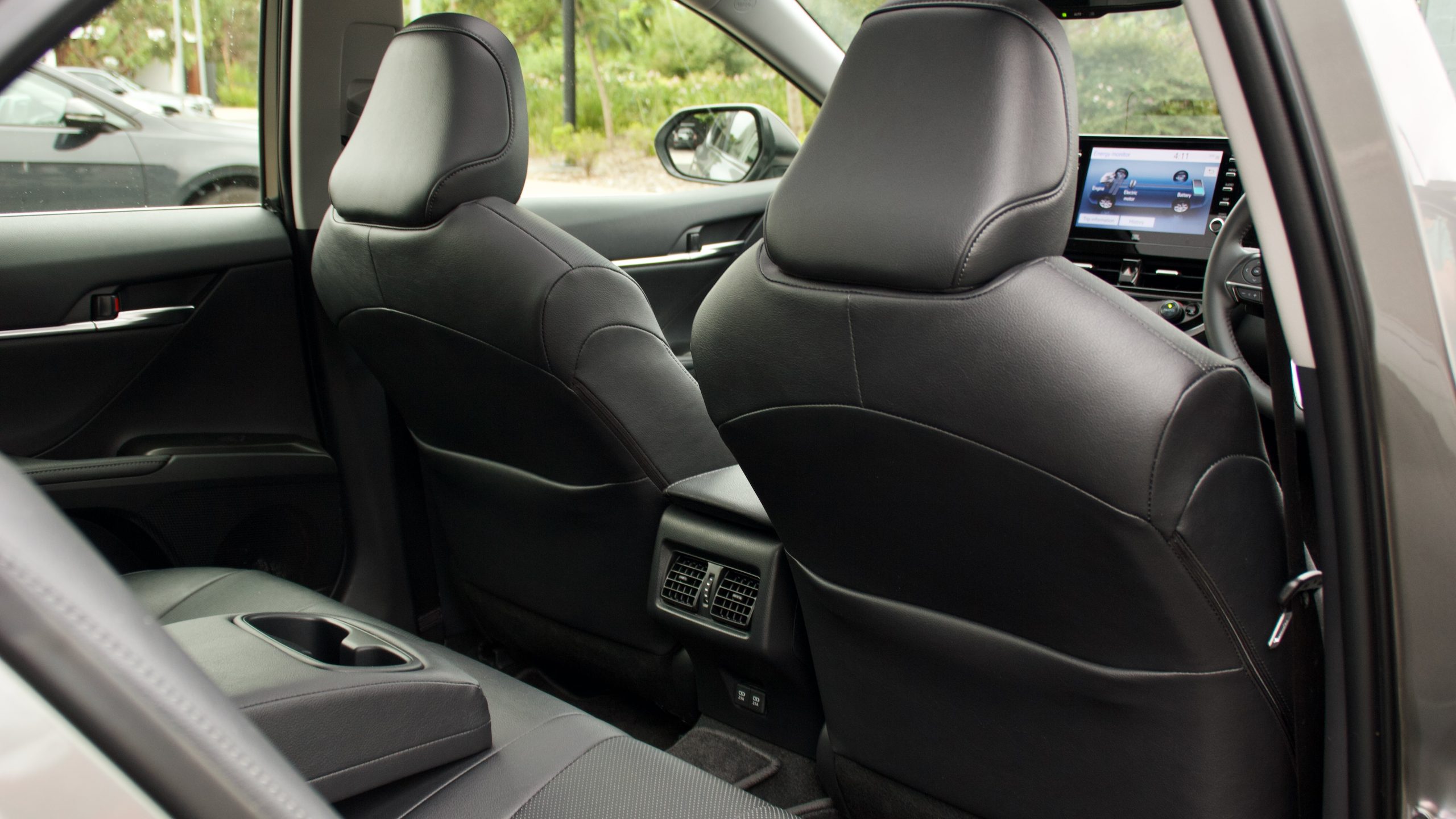
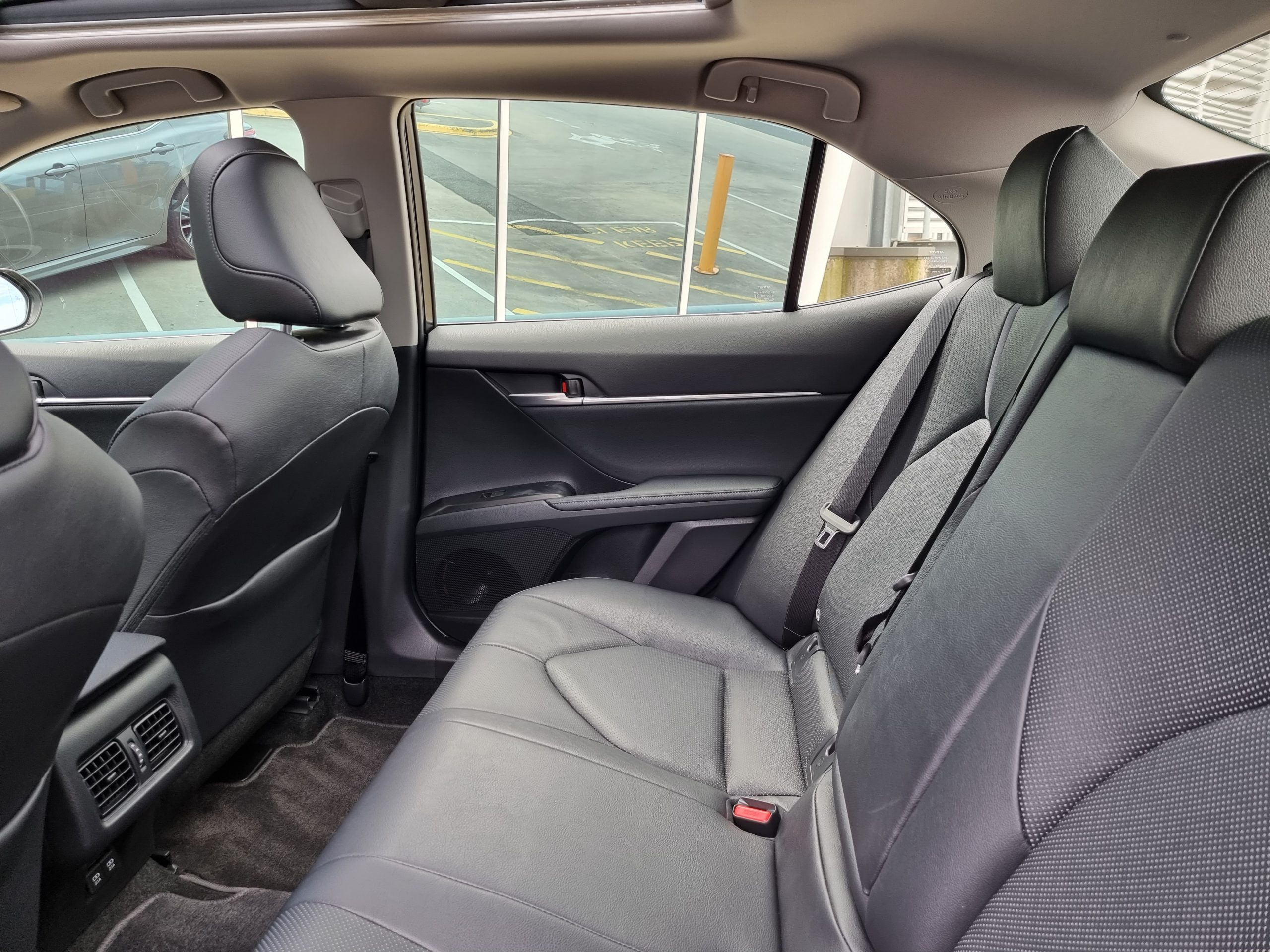
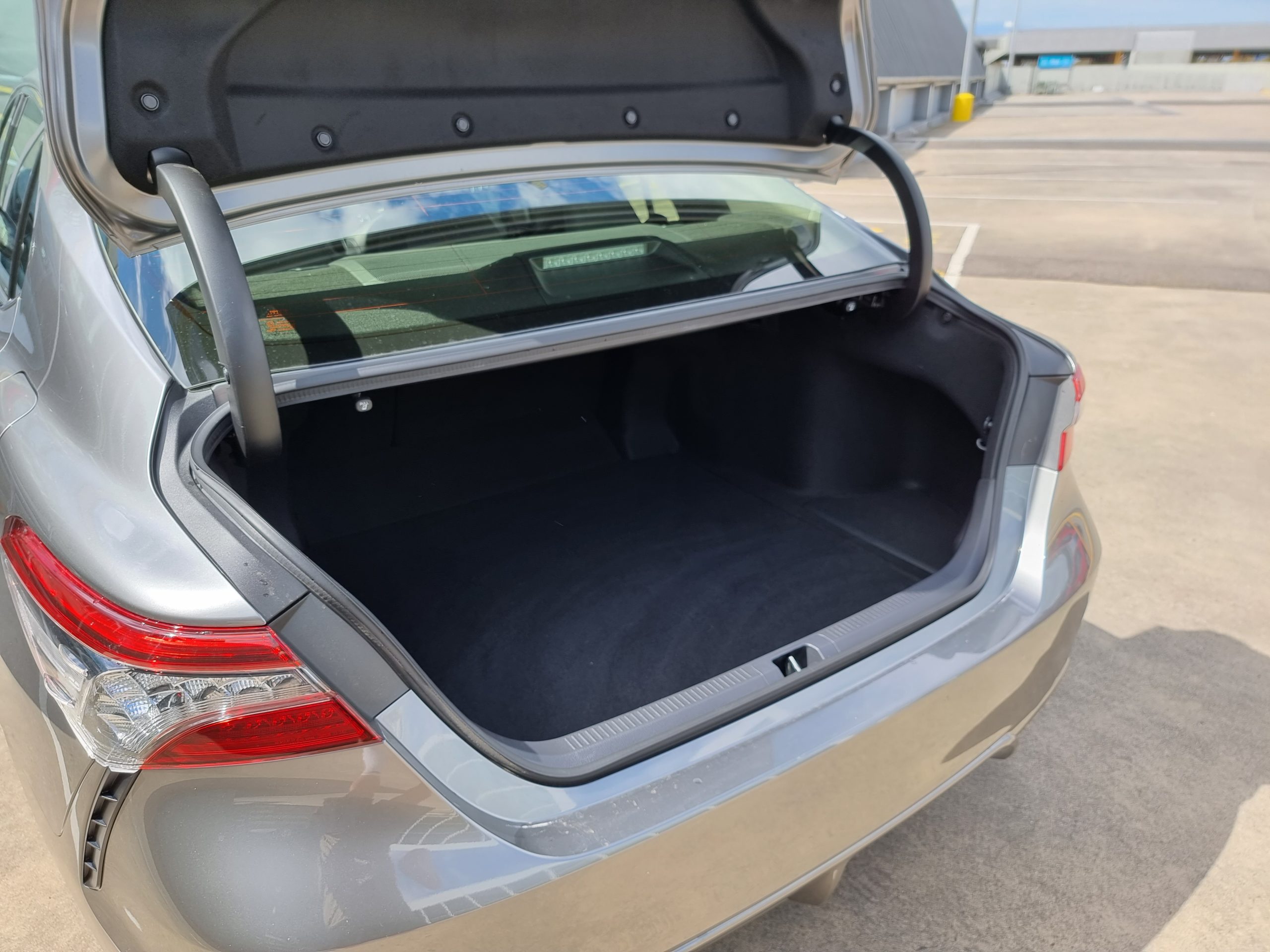
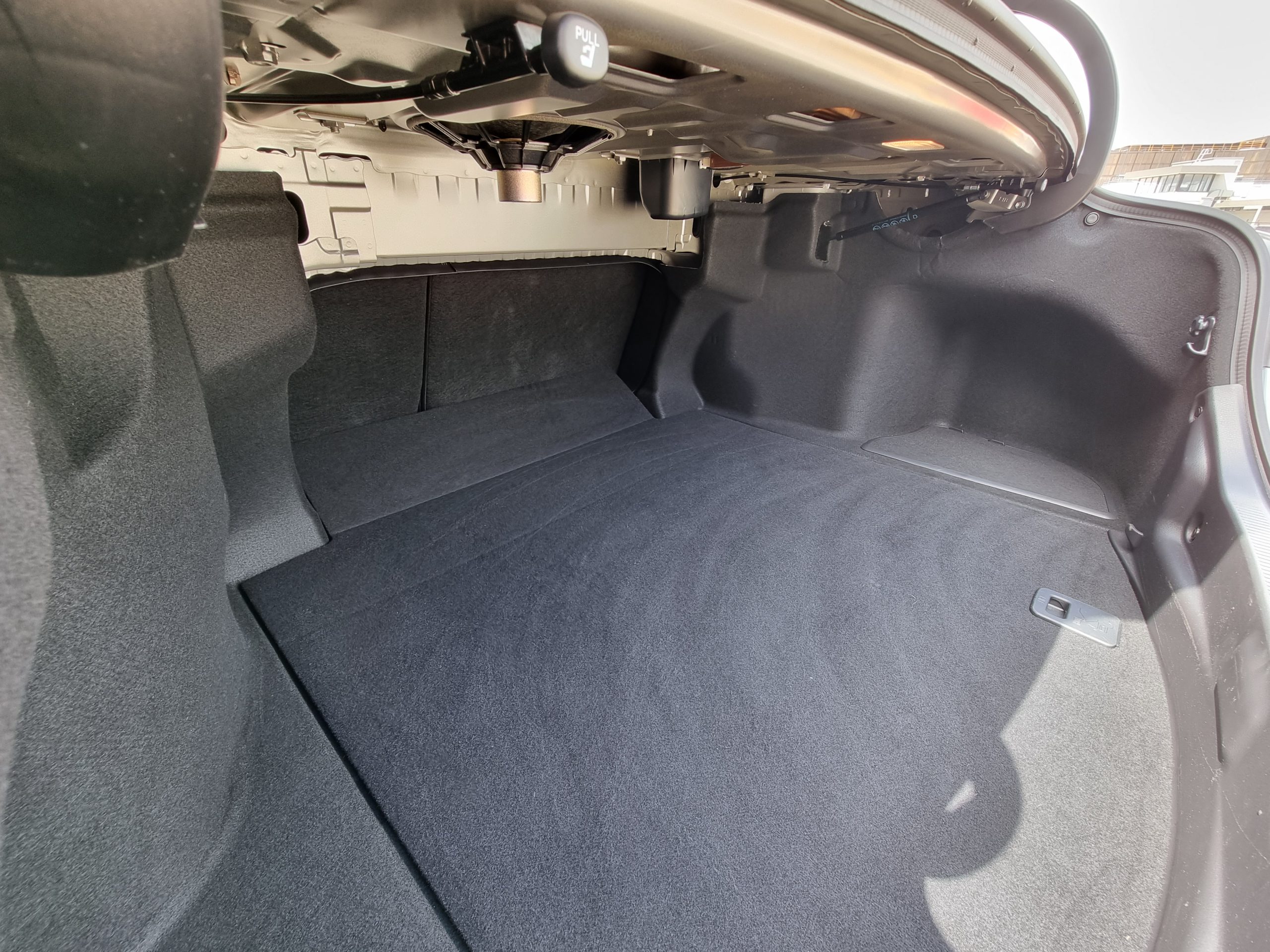
The 2022 Toyota Camry SL Hybrid has a voluminous boot with 524-litres of space, which can be expanded upon by folding the rear seats. Of its competitors, the Camry has 50 more litres than the Mazda 6 (474L), but less than the Honda Accord (570L) and Skoda Octavia (600L). Boot hooks are provided to hang bags or other items from and a space saver-space saver spare wheel. We think the Camry’s boot can more than offset the need for an SUV like the RAV4.
Service & Warranty: 9/10
Toyota provides a five-year/unlimited km warranty on the Camry, which is extended to seven years of the engine and driveline if annual servicing has been carried out as per the logbook requirements. The extra two years for engine and driveline is unique, as is the extra five years for the hybrid battery. The Camry SL hybrid costs only $220 for each of the first five services, which are required every twelve months, or 15,000kms, adding up to a total of $1,100 for servicing over the first five years.
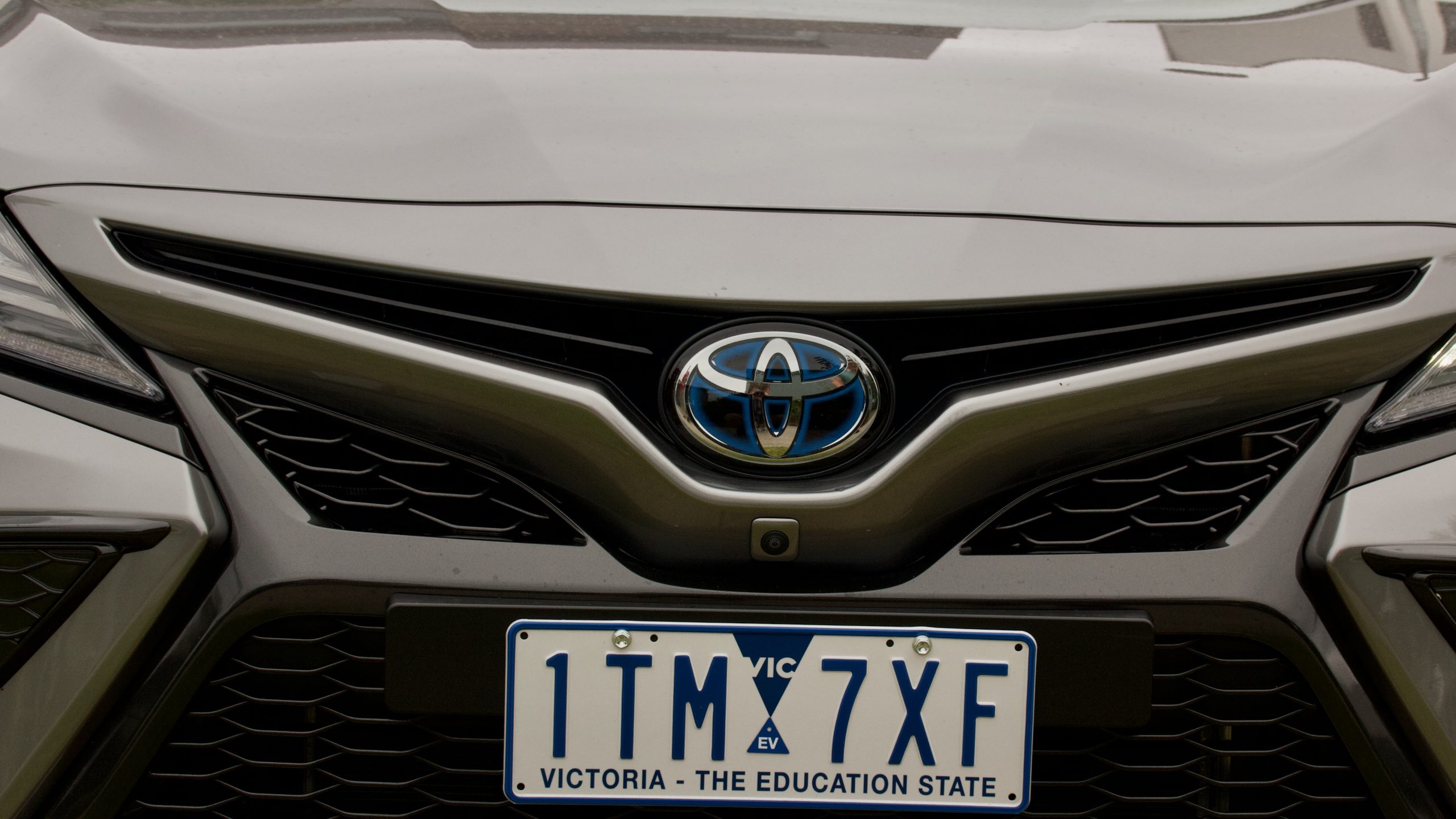
While Toyota used to rule the roost in terms of the lowest price servicing, it has been undercut by Honda’s $115 services, with the Accord hybrid only costing a total of $625 for the first five years. Toyota’s servicing, however, is cheaper than most other competitors, with the Mazda6 Atenza costing $1,805 to service over the first five years and the Skoda Octavia 140TSI costing $2,783 across the same period. Toyota don’t offer any included roadside assistance with the Camry SL hybrid, compared with the Octavia, which includes one year of roadside assistance until serviced at a dealership, and the Mazda6 and Accord, which both include five years of roadside assistance.
The 2022 Toyota Camry 2022 SL Hybrid DiscoverAuto Rating: 8.2/10
The 2022 Toyota Camry SL hybrid retrains plenty of ‘Camry DNA’—it’s easy to drive, super practical and very well put together. The 2022 Camry doesn’t rest on these laurels, though, and the 2021 facelift has helped keep it feeling fresh. The hybrid drivetrain is refined but also surprisingly capable, achieving fantastic efficiency. This, combined with low servicing costs, makes the Camry make a lot of sense.
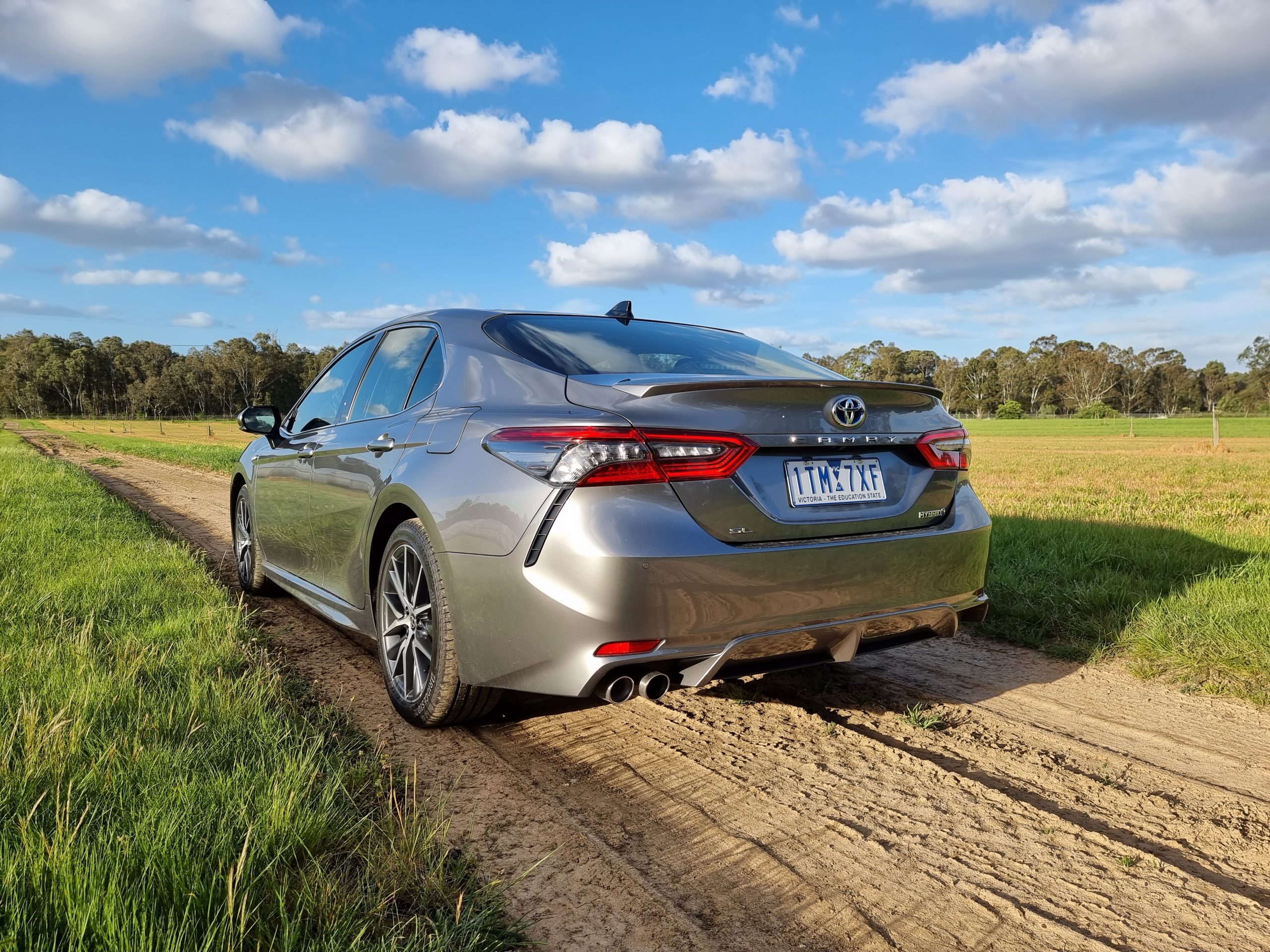
We found the interior and exterior to be classy, and dare we say it, bordering on sporty. While there are a few equipment upgrades and additions we’d like to see, the 2022 Camry makes sense as a great SUV alternative for families and demonstrates that a mid-size sedan doesn’t have to be boring.
Review written by David Diekman
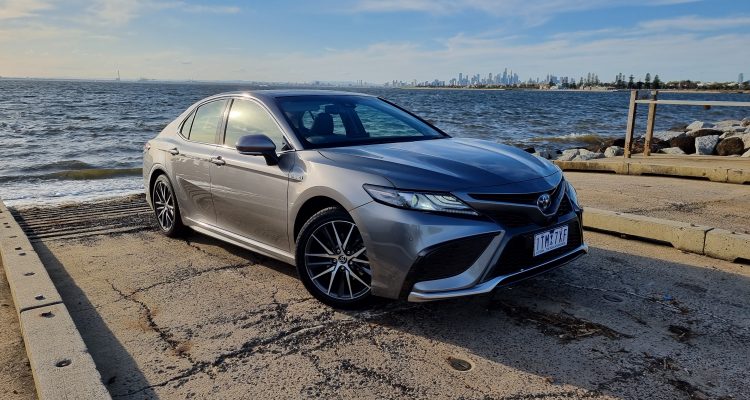
The Camry V6 has gone. What a shame. Toyota: Bring back the Camry V6. Add a Quark style electric motor to the rear axle.
The wait is a problem. When i ordered in March was told 4 to 6 months. Now after 7 months they admit it may be more than 10 months if I am lucky
Hi Shane, sorry to hear about the wait – hopefully it’s not too much longer – wait times at the moment are crazy!
Hi Shane, we ordered our SL early June, told 6 months. Now 7 too. Having all plants in Japan close down in Oct/Nov due to shortage of parts has obviously delayed production. But how much longer?
Ordered at Leeton Toyota NSW, a Camry SL hybred , March 2022 then transferd to Owen toyota Griffth NSW .
I inquired January 2023 at Leeton, production towads 2024 maybe.
That will most lickly be the remodled camry. Looks as if it will take up towards the end of the decade to get a Japan Toyota Camry SL.